
confabulations
Hallucinations (Confabulations) Document-Based Benchmark for RAG
Stars: 90
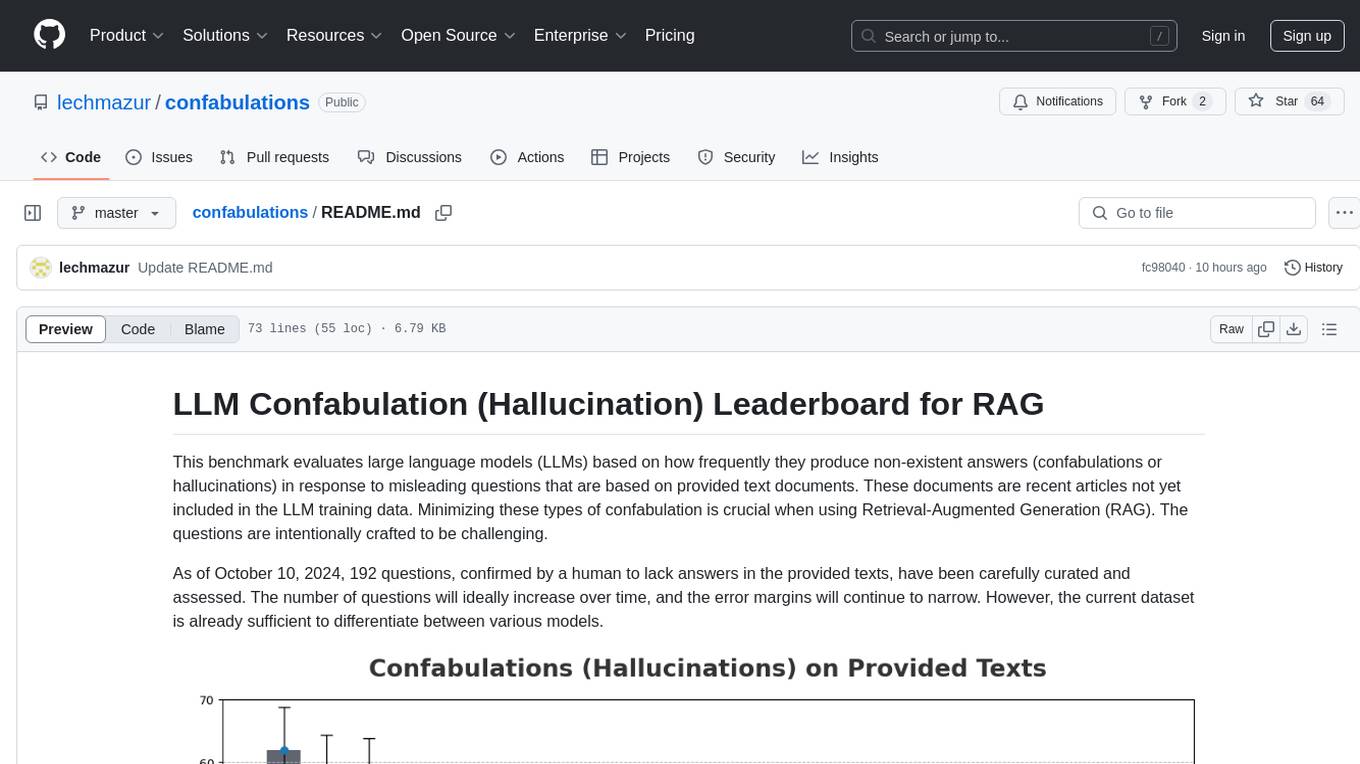
LLM Confabulation Leaderboard evaluates large language models based on confabulations and non-response rates to challenging questions. It includes carefully curated questions with no answers in provided texts, aiming to differentiate between various models. The benchmark combines confabulation and non-response rates for comprehensive ranking, offering insights into model performance and tendencies. Additional notes highlight the meticulous human verification process, challenges faced by LLMs in generating valid responses, and the use of temperature settings. Updates and other benchmarks are also mentioned, providing a holistic view of the evaluation landscape.
README:
This benchmark evaluates large language models (LLMs) based on how frequently they produce non-existent answers (confabulations or hallucinations) in response to misleading questions that are based on provided text documents. These documents are recent articles not yet included in the LLM training data. Minimizing these types of confabulation is crucial when using Retrieval-Augmented Generation (RAG). The questions are intentionally crafted to be challenging.
As of Feb 10, 2025, 201 questions, confirmed by a human to lack answers in the provided texts, have been carefully curated and assessed. The number of questions will ideally increase over time, and the error margins will continue to narrow. However, the current dataset is already sufficient to differentiate between various models.
Combining confabulation and non-response rates enables a comprehensive ranking. Depending on your priorities, you may prefer fewer confabulations or fewer non-responses.
| Rank | Model | Confab % | Non-Resp % | Weighted |
|---|---|---|---|---|
| 1 | o1 | 10.9 | 12.6 | 11.74 |
| 2 | Gemini 2.0 Flash Think Exp 01-21 | 14.9 | 10.0 | 12.43 |
| 3 | DeepSeek R1 | 17.3 | 8.0 | 12.65 |
| 4 | o1-preview | 18.3 | 7.8 | 13.04 |
| 5 | Gemini 1.5 Pro (Sept) | 16.8 | 10.2 | 13.54 |
| 6 | GPT-4o | 22.3 | 8.4 | 15.34 |
| 7 | Llama 3.1 405B | 14.4 | 20.9 | 17.62 |
| 8 | o3-mini (medium reasoning) | 27.2 | 8.6 | 17.91 |
| 9 | Gemini 2.0 Pro Exp 02-05 | 15.8 | 21.0 | 18.43 |
| 10 | o1-mini | 26.2 | 10.9 | 18.55 |
| 11 | Qwen 2.5 72B | 32.2 | 6.0 | 19.09 |
| 12 | DeepSeek-V3 | 24.3 | 14.2 | 19.23 |
| 13 | Claude 3.5 Sonnet 2024-10-22 | 12.9 | 27.0 | 19.94 |
| 14 | Grok 2 12-12 | 25.7 | 14.5 | 20.14 |
| 15 | Mistral Large 2 | 32.2 | 10.6 | 21.40 |
| 16 | Qwen 2.5 Max | 31.2 | 12.4 | 21.78 |
| 17 | Claude 3 Opus | 28.2 | 17.2 | 22.70 |
| 18 | Llama 3.3 70B | 17.8 | 27.8 | 22.81 |
| 19 | MiniMax-Text-01 | 44.6 | 3.3 | 23.92 |
| 20 | Mistral Small 3 | 38.6 | 11.8 | 25.21 |
| 21 | Gemini 2.0 Flash | 24.3 | 29.4 | 26.85 |
| 22 | Gemma 2 27B | 47.3 | 7.2 | 27.24 |
| 23 | GPT-4 Turbo | 26.7 | 30.1 | 28.42 |
| 24 | Microsoft Phi-4 | 52.5 | 6.5 | 29.49 |
| 25 | Amazon Nova Pro | 54.5 | 5.6 | 30.05 |
| 26 | Claude 3 Haiku | 56.9 | 11.5 | 34.21 |
| 27 | Claude 3.5 Haiku | 65.8 | 7.6 | 36.74 |
| 28 | GPT-4o mini | 60.9 | 13.5 | 37.21 |
The raw confabulation rate alone isn't sufficient for meaningful evaluation. A model that simply declines to answer most questions would achieve a low confabulation rate. To address this, the benchmark also tracks the LLM non-response rate using the same prompts and documents but specific questions with answers that are present in the text. Currently, 2,612 hard questions (see the prompts) with known answers in the texts are included in this analysis.
Accuracy benchmarks can also be considered for a more comprehensive assessment. This benchmark currently focuses solely on pure confabulations to keep it distinct for now. However, I have created a separate benchmark to test LLMs using the extended version of the New York Times Connections.
- Reasoning appears to help. For example, DeepSeek R1 performs better than DeepSeek-V3 and Gemini 2.0 Flash Thinking Exp 01-21 performs better than Gemini 2.0 Flash.
- OpenAI o1 confabulates less than DeepSeek R1, but R1 answers questions with known answers more frequently.
- GPT-4o shows a significant improvement over GPT-4 Turbo.
- Gemini 1.5 Pro (September) performs better than Claude models, but there is no improvement with Gemini 2.0 Pro Exp 02-05.
- Llama models tend to respond cautiously, resulting in fewer confabulations but higher non-response rates
- A popular hallucination leaderboard on GitHub uses a model for evaluation of document summaries, but I found this to lead to a very high error rate and different rankings. This approach can be very misleading.
- While the initial set of questions was suggested by LLMs, the final 201 questions were all painstakingly human-verified to have no answers in the provided texts. Only a percentage of LLM-suggested questions were unequivocally answer-free.
- Despite clear prompts, LLMs often generated compound questions that effectively asked for two answers. These were removed in a separate judging step.
- The benchmark includes questions where at least one LLM confabulated, in order to minimize the number of questions requiring human assessment. Because of this, and since the questions are intentionally adversarial, the absolute percentage should not be used to infer that LLMs frequently confabulate. This leaderboard does not reflect a "typical" hallucination rate.
- In some cases, LLMs failed to provide valid responses to the questions, such as skipping certain questions altogether. This occurred only once for the human-selected questions without valid answers in the text (bad Gemma, bad), but happened more frequently for questions with valid answers. These questions were discarded.
- A temperature setting of 0 was used
- Multi-turn ensemble is my unpublished system. It utilizes multiple LLMs (that existed in Oct 2024), multi-turn dialogues, and other proprietary techniques. It is slower and more costly to run but it does very well. It outperforms non-o1 LLMs on MMLU-Pro and GPQA.
- Feb 10, 2025: 17 human-verified questions based on Jan 2025-Feb 2025 articles added. 176 answerable questions added.
- Feb 7, 2025: DeepSeek R1, o1, o3-mini (medium reasoning effort), DeepSeek-V3, Gemini 2.0 Flash Thinking Exp 01-21, Qwen 2.5 Max, Microsoft Phi-4, Amazon Nova Pro, Mistral Small 3, MiniMax-Text-01 added.
- Nov. 5, 2024: Claude 3.5 Haiku added
- Oct. 23, 2024: Grok Beta added
- Oct. 23, 2024: Claude 3.5 Sonnet (2024-10-22) added
- Oct. 15, 2024: Grok 2 added
- Also check out Multi-Agent Elimination Game LLM Benchmark, LLM Public Goods Game, LLM Step Game, LLM Thematic Generalization Benchmark, LLM Creative Story-Writing Benchmark, LLM Deception Benchmark and LLM Divergent Thinking Creativity Benchmark.
- Follow @lechmazur on X (Twitter) for other upcoming benchmarks and more.
| Rank | Model | Confab % | Non-Resp % | Weighted |
|---|---|---|---|---|
| 1 | Multi-turn ensemble | 11.4 | 8.5 | 9.94 |
| 2 | DeepSeek R1 | 14.6 | 7.7 | 11.13 |
| 3 | o1 | 10.3 | 12.2 | 11.21 |
| 4 | Gemini 2.0 Flash Think Exp 01-21 | 13.0 | 10.1 | 11.56 |
| 5 | o1-preview | 16.8 | 7.4 | 12.07 |
| 6 | Gemini 1.5 Pro (Sept) | 16.8 | 9.7 | 13.24 |
| 7 | GPT-4o | 18.4 | 8.5 | 13.44 |
| 8 | Llama 3.1 405B | 11.9 | 20.8 | 16.35 |
| 9 | o3-mini (medium reasoning) | 24.3 | 8.5 | 16.43 |
| 10 | Gemini 2.0 Pro Exp 02-05 | 13.0 | 21.0 | 16.97 |
| 11 | o1-mini | 24.3 | 10.2 | 17.25 |
| 12 | DeepSeek-V3 | 21.1 | 14.5 | 17.79 |
| 13 | Qwen 2.5 72B | 30.3 | 5.8 | 18.03 |
| 14 | Grok 2 12-12 | 24.3 | 14.5 | 19.43 |
| 15 | Claude 3.5 Sonnet 2024-10-22 | 11.9 | 27.8 | 19.82 |
| 16 | Mistral Large 2 | 30.8 | 9.2 | 19.98 |
| 17 | Qwen 2.5 Max | 28.1 | 12.3 | 20.20 |
| 18 | Claude 3 Opus | 26.5 | 15.9 | 21.21 |
| 19 | MiniMax-Text-01 | 40.0 | 3.1 | 21.54 |
| 20 | Claude 3.5 Sonnet Old | 27.0 | 16.1 | 21.58 |
| 21 | Llama 3.1 70B | 13.5 | 31.4 | 22.46 |
| 22 | Llama 3.3 70B | 16.2 | 29.4 | 22.78 |
| 23 | Grok 2 | 24.3 | 22.7 | 23.53 |
| 24 | Gemini 1.5 Flash | 42.2 | 5.2 | 23.69 |
| 25 | Grok Beta | 24.3 | 23.4 | 23.84 |
| 26 | Mistral Small 3 | 35.7 | 12.5 | 24.10 |
| 27 | Gemma 2 27B | 44.3 | 7.1 | 25.71 |
| 28 | Gemini 2.0 Flash Exp | 23.2 | 29.9 | 26.58 |
| 29 | Gemini 2.0 Flash | 23.2 | 30.3 | 26.75 |
| 30 | Microsoft Phi-4 | 48.6 | 6.0 | 27.28 |
| 31 | GPT-4 Turbo | 23.8 | 31.4 | 27.59 |
| 32 | Amazon Nova Pro | 51.4 | 5.8 | 28.58 |
| 33 | DeepSeek-V2.5 | 33.5 | 25.6 | 29.54 |
| 34 | Claude 3 Haiku | 57.3 | 10.4 | 33.86 |
| 35 | Claude 3.5 Haiku | 63.2 | 6.8 | 35.03 |
For Tasks:
Click tags to check more tools for each tasksFor Jobs:
Alternative AI tools for confabulations
Similar Open Source Tools

confabulations
LLM Confabulation Leaderboard evaluates large language models based on confabulations and non-response rates to challenging questions. It includes carefully curated questions with no answers in provided texts, aiming to differentiate between various models. The benchmark combines confabulation and non-response rates for comprehensive ranking, offering insights into model performance and tendencies. Additional notes highlight the meticulous human verification process, challenges faced by LLMs in generating valid responses, and the use of temperature settings. Updates and other benchmarks are also mentioned, providing a holistic view of the evaluation landscape.
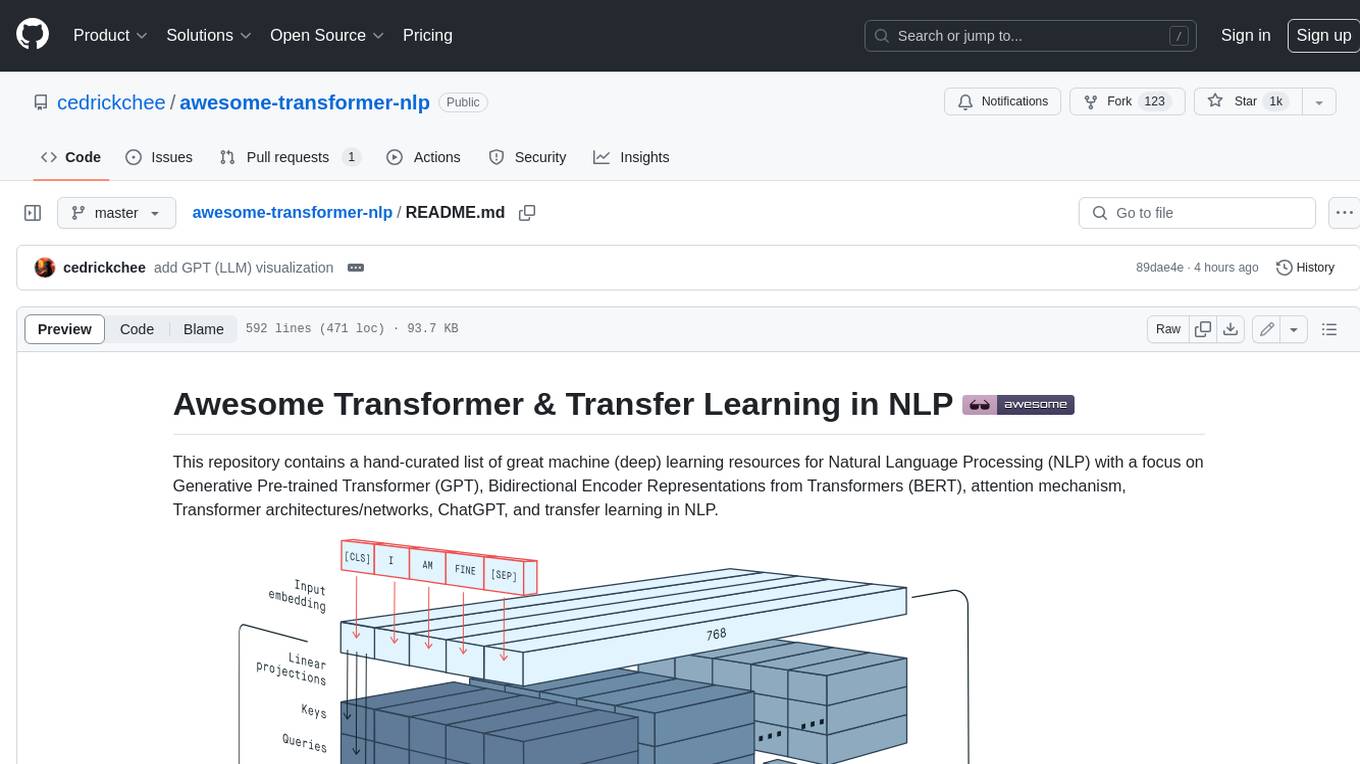
awesome-transformer-nlp
This repository contains a hand-curated list of great machine (deep) learning resources for Natural Language Processing (NLP) with a focus on Generative Pre-trained Transformer (GPT), Bidirectional Encoder Representations from Transformers (BERT), attention mechanism, Transformer architectures/networks, Chatbot, and transfer learning in NLP.
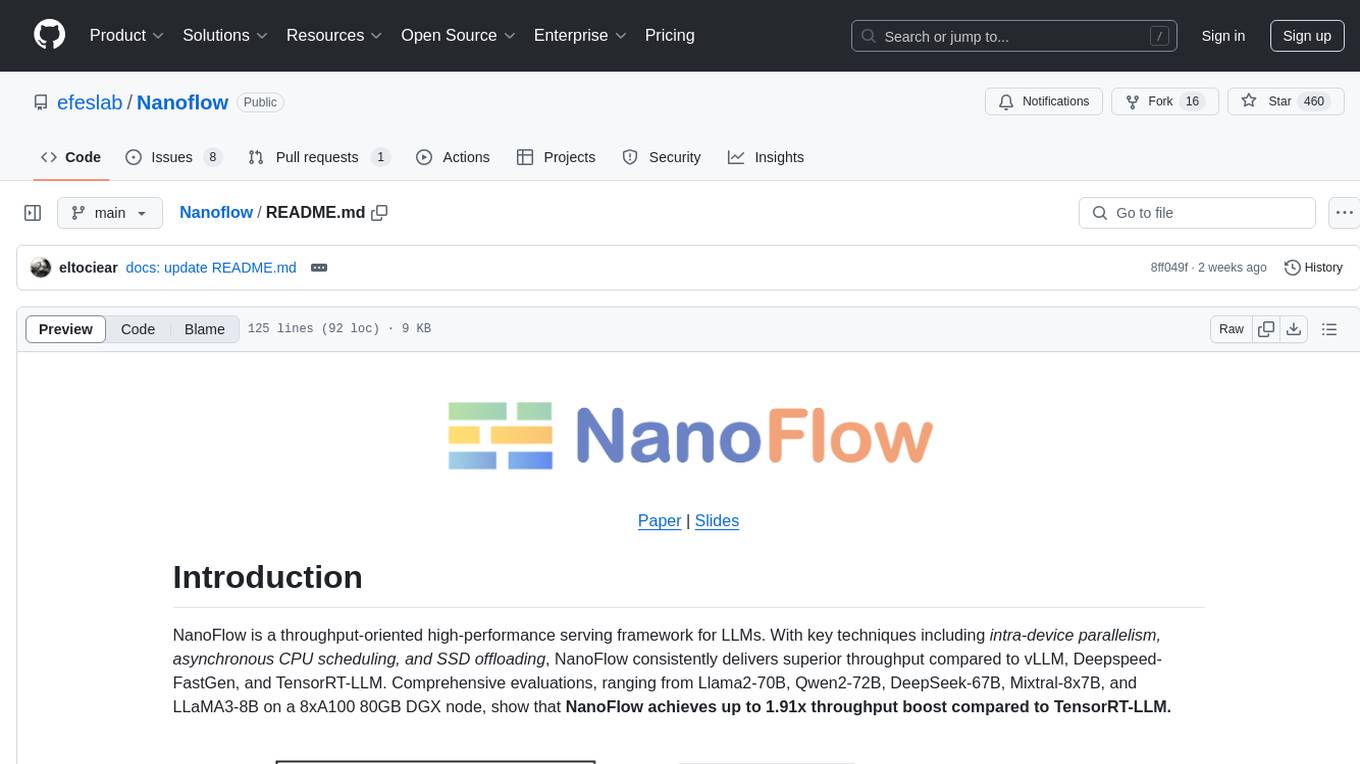
Nanoflow
NanoFlow is a throughput-oriented high-performance serving framework for Large Language Models (LLMs) that consistently delivers superior throughput compared to other frameworks by utilizing key techniques such as intra-device parallelism, asynchronous CPU scheduling, and SSD offloading. The framework proposes nano-batching to schedule compute-, memory-, and network-bound operations for simultaneous execution, leading to increased resource utilization. NanoFlow also adopts an asynchronous control flow to optimize CPU overhead and eagerly offloads KV-Cache to SSDs for multi-round conversations. The open-source codebase integrates state-of-the-art kernel libraries and provides necessary scripts for environment setup and experiment reproduction.
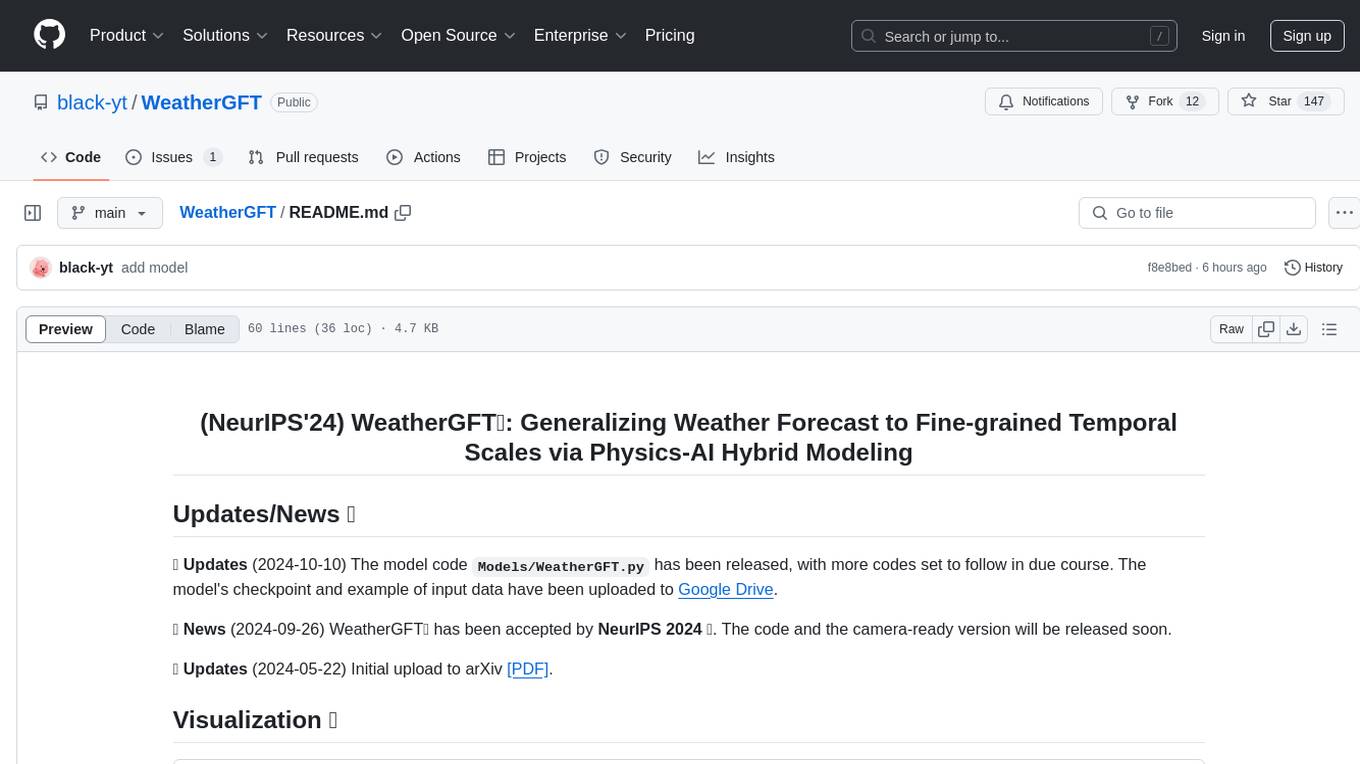
WeatherGFT
WeatherGFT is a physics-AI hybrid model designed to generalize weather forecasts to finer-grained temporal scales beyond the training dataset. It incorporates physical partial differential equations (PDEs) into neural networks to simulate fine-grained physical evolution and correct biases. The model achieves state-of-the-art performance in forecasting tasks at different time scales, from nowcasting to medium-range forecasts, by utilizing a lead time-aware training framework and a carefully designed PDE kernel. WeatherGFT bridges the gap between nowcast and medium-range forecast by extending forecasting abilities to predict accurately at a 30-minute time scale.
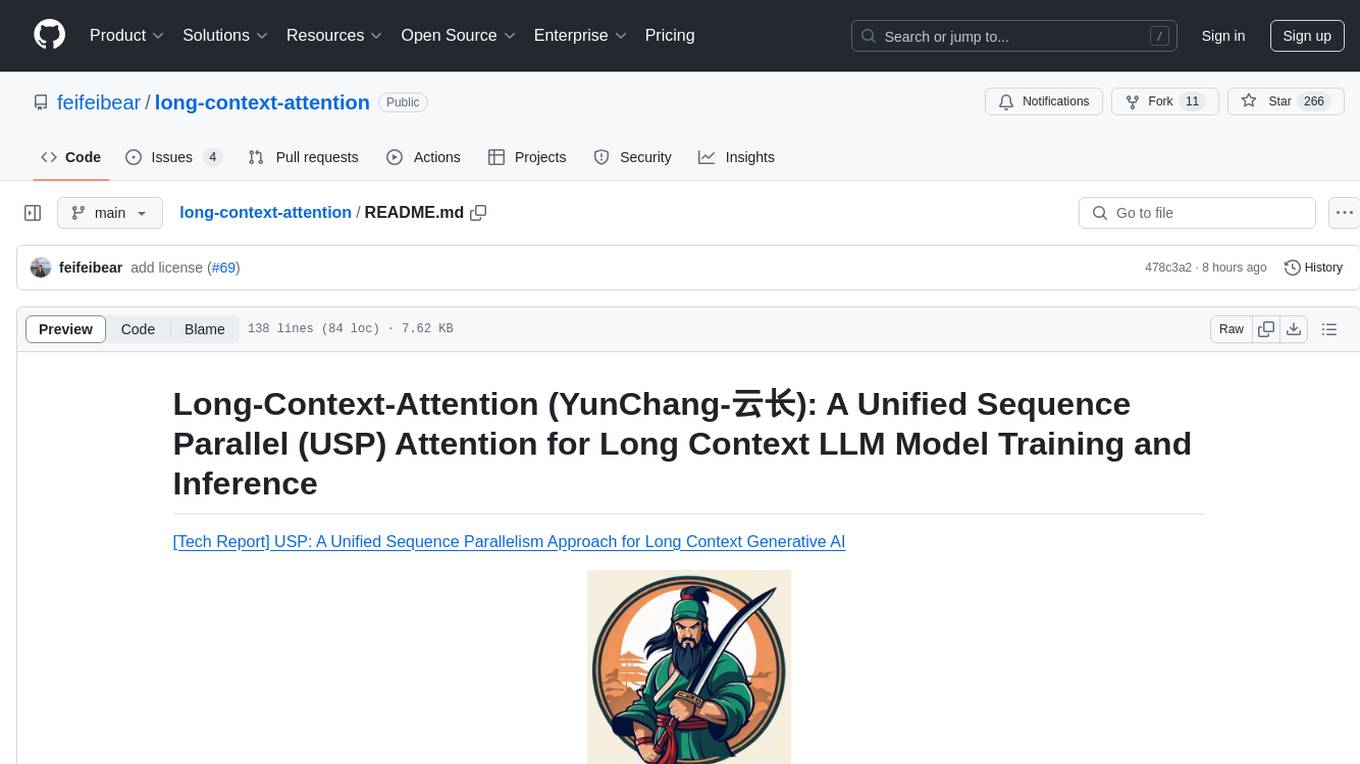
long-context-attention
Long-Context-Attention (YunChang) is a unified sequence parallel approach that combines the strengths of DeepSpeed-Ulysses-Attention and Ring-Attention to provide a versatile and high-performance solution for long context LLM model training and inference. It addresses the limitations of both methods by offering no limitation on the number of heads, compatibility with advanced parallel strategies, and enhanced performance benchmarks. The tool is verified in Megatron-LM and offers best practices for 4D parallelism, making it suitable for various attention mechanisms and parallel computing advancements.
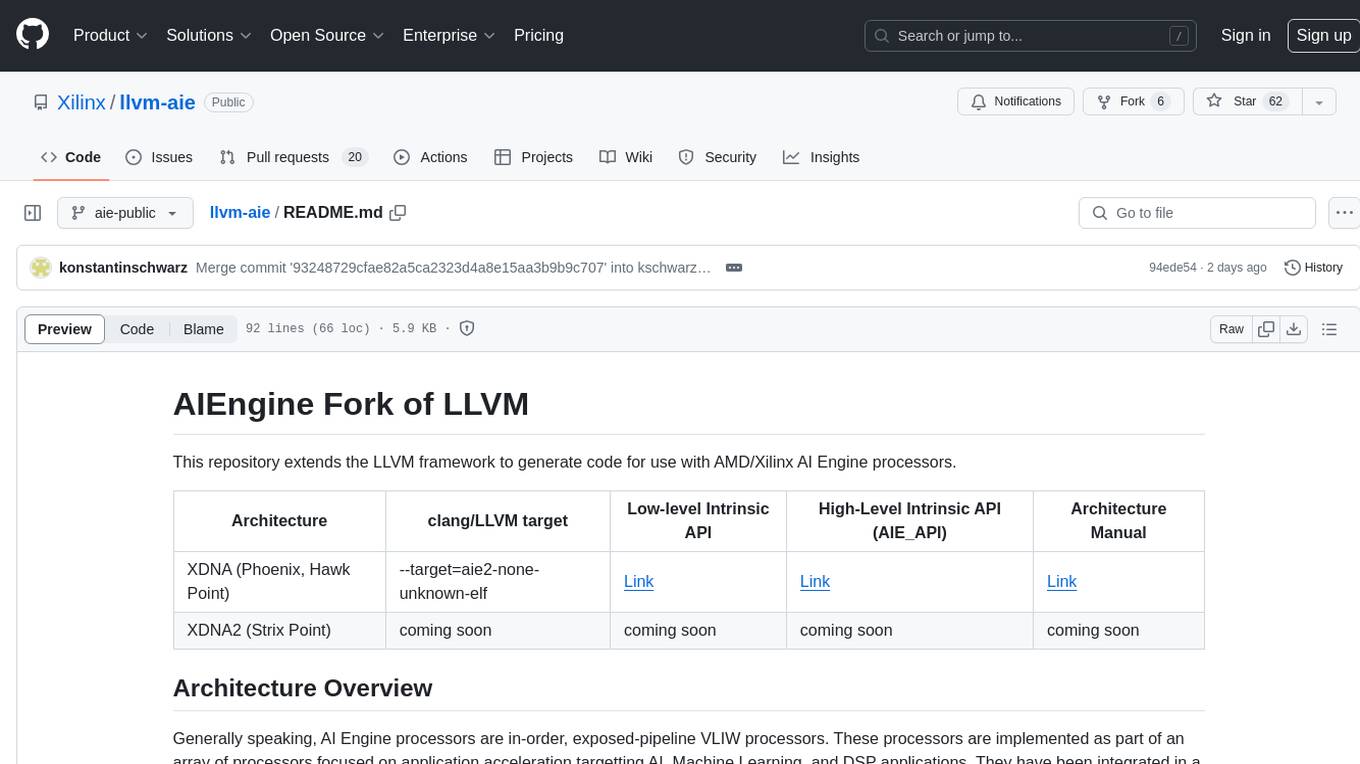
llvm-aie
This repository extends the LLVM framework to generate code for use with AMD/Xilinx AI Engine processors. AI Engine processors are in-order, exposed-pipeline VLIW processors focused on application acceleration for AI, Machine Learning, and DSP applications. The repository adds LLVM support for specific features like non-power of 2 pointers, operand latencies, resource conflicts, negative operand latencies, slot assignment, relocations, code alignment restrictions, and register allocation. It includes support for Clang, LLD, binutils, Compiler-RT, and LLVM-LIBC.
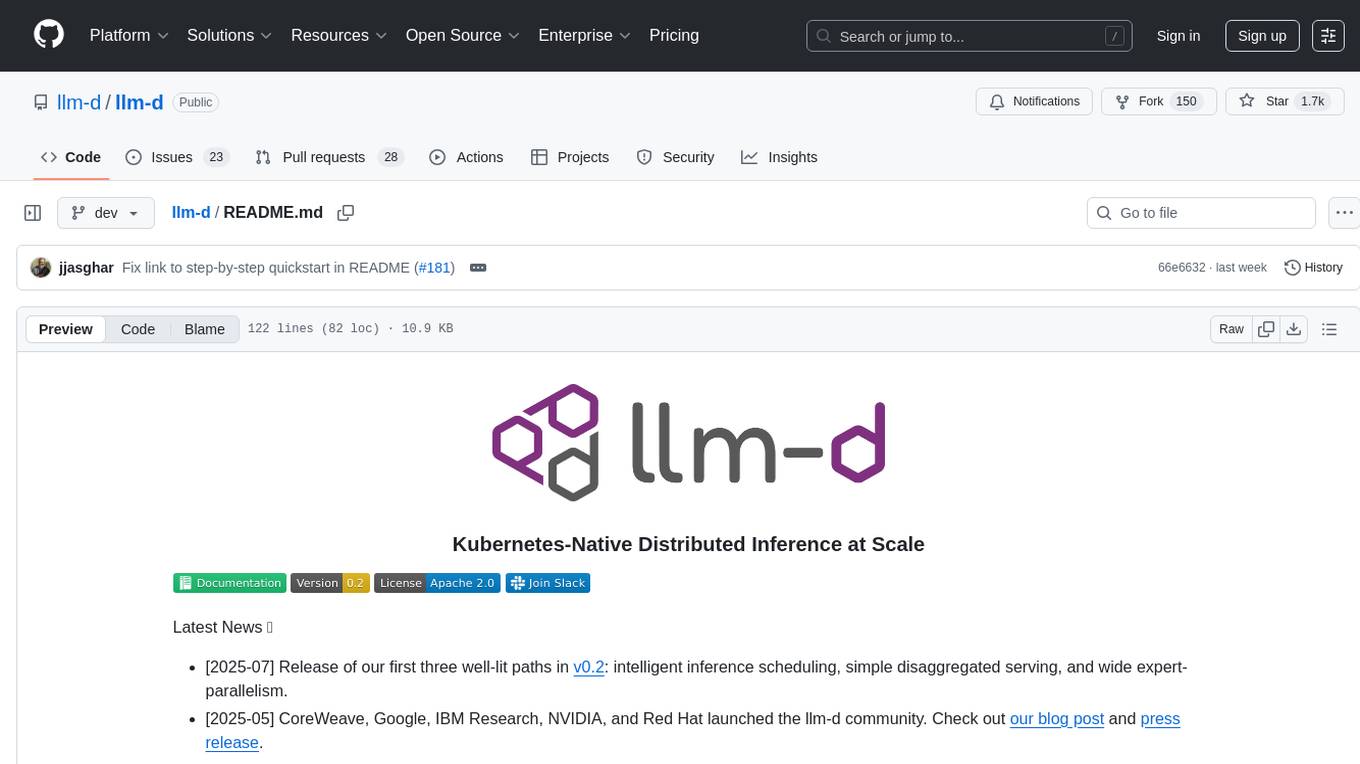
llm-d
LLM-D is a machine learning model for sentiment analysis. It is designed to classify text data into positive, negative, or neutral sentiment categories. The model is trained on a large dataset of labeled text samples and uses natural language processing techniques to analyze and predict sentiment in new text inputs. LLM-D is a powerful tool for businesses and researchers looking to understand customer feedback, social media sentiment, and other text data sources. It can be easily integrated into existing applications or used as a standalone tool for sentiment analysis tasks.
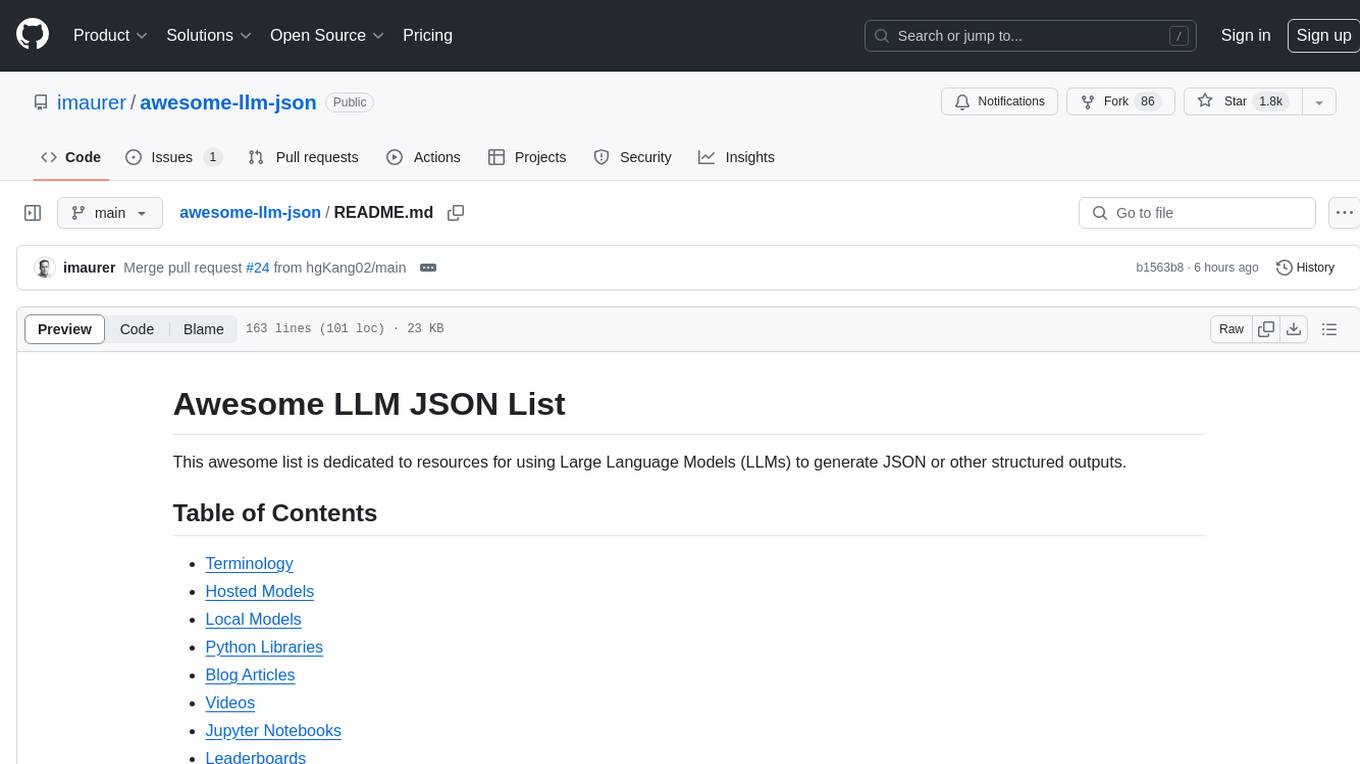
awesome-llm-json
This repository is an awesome list dedicated to resources for using Large Language Models (LLMs) to generate JSON or other structured outputs. It includes terminology explanations, hosted and local models, Python libraries, blog articles, videos, Jupyter notebooks, and leaderboards related to LLMs and JSON generation. The repository covers various aspects such as function calling, JSON mode, guided generation, and tool usage with different providers and models.
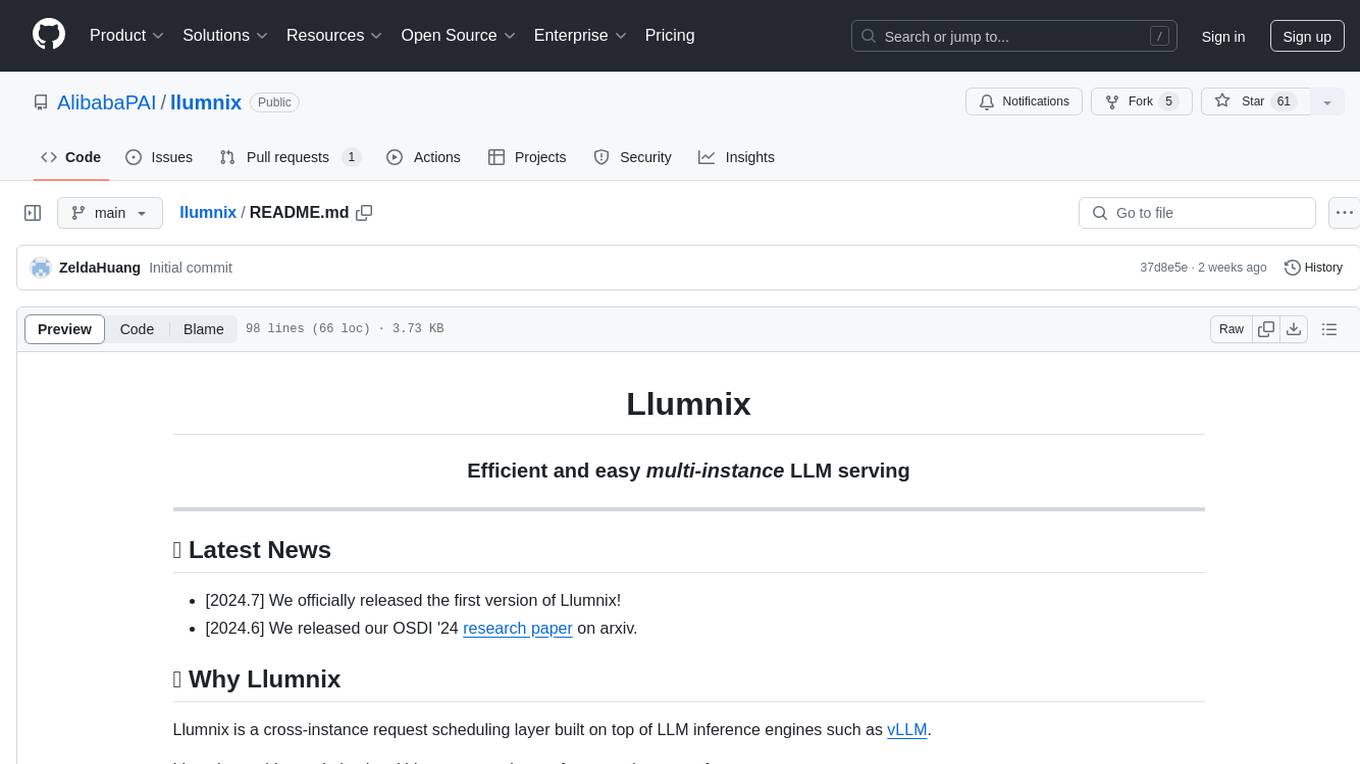
llumnix
Llumnix is a cross-instance request scheduling layer built on top of LLM inference engines such as vLLM, providing optimized multi-instance serving performance with low latency, reduced time-to-first-token (TTFT) and queuing delays, reduced time-between-tokens (TBT) and preemption stalls, and high throughput. It achieves this through dynamic, fine-grained, KV-cache-aware scheduling, continuous rescheduling across instances, KV cache migration mechanism, and seamless integration with existing multi-instance deployment platforms. Llumnix is easy to use, fault-tolerant, elastic, and extensible to more inference engines and scheduling policies.
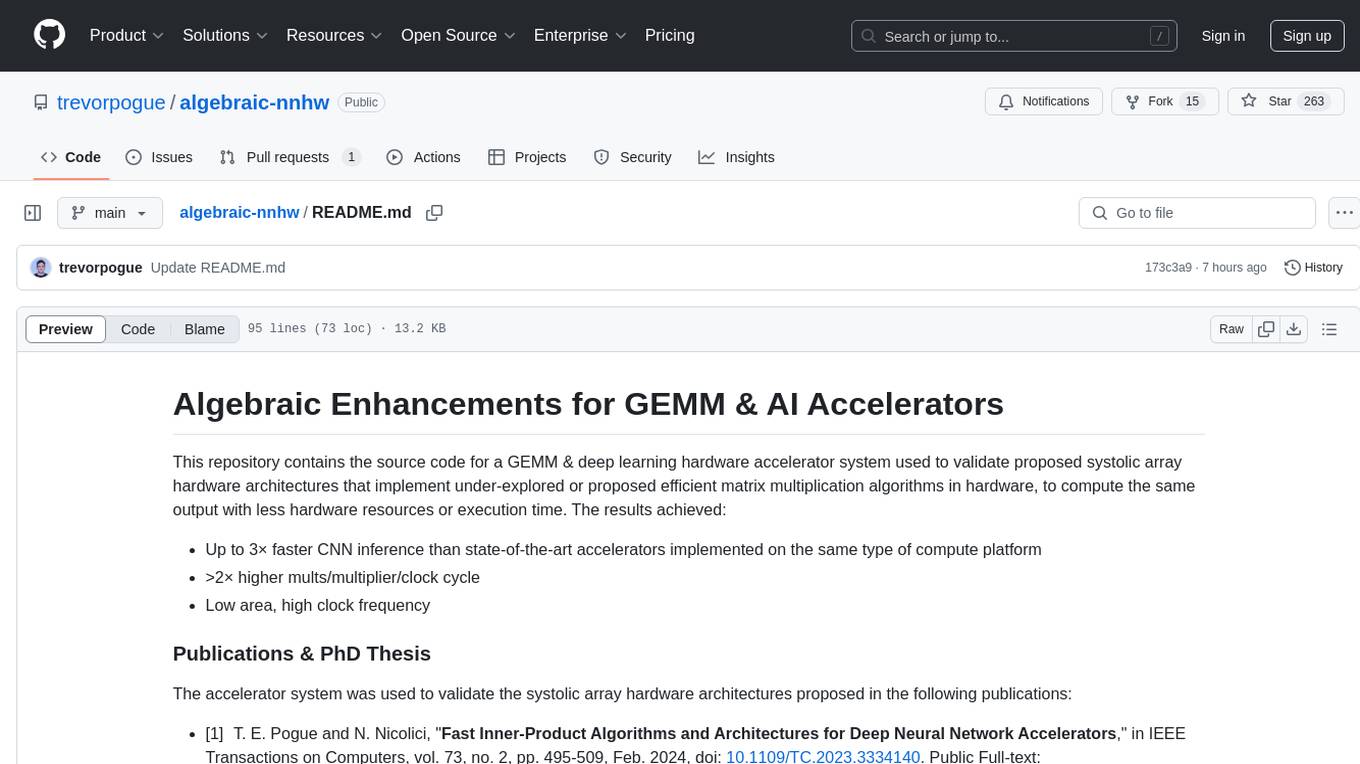
algebraic-nnhw
This repository contains the source code for a GEMM & deep learning hardware accelerator system used to validate proposed systolic array hardware architectures implementing efficient matrix multiplication algorithms to increase performance-per-area limits of GEMM & AI accelerators. Achieved results include up to 3× faster CNN inference, >2× higher mults/multiplier/clock cycle, and low area with high clock frequency. The system is specialized for inference of non-sparse DNN models with fixed-point/quantized inputs, fully accelerating all DNN layers in hardware, and highly optimizing GEMM acceleration.
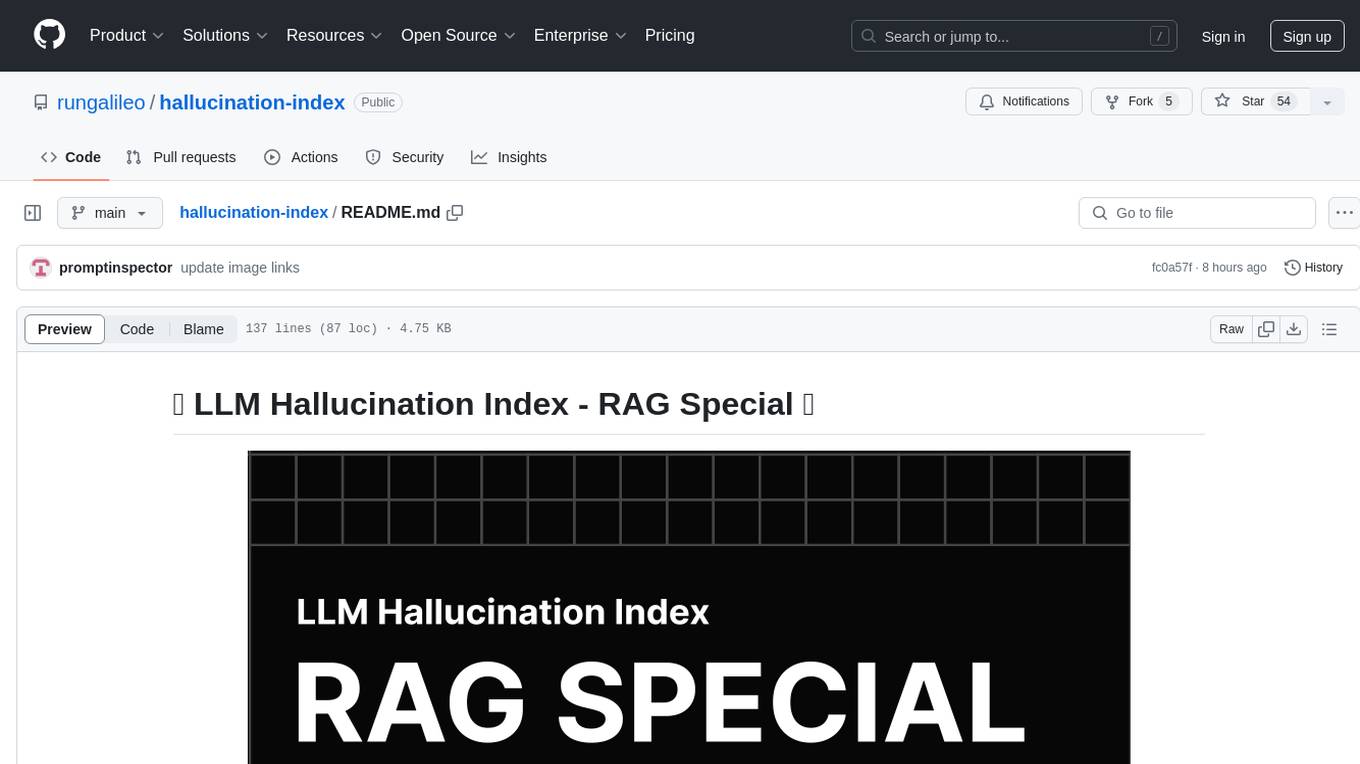
hallucination-index
LLM Hallucination Index - RAG Special is a comprehensive evaluation of large language models (LLMs) focusing on context length and open vs. closed-source attributes. The index explores the impact of context length on model performance and tests the assumption that closed-source LLMs outperform open-source ones. It also investigates the effectiveness of prompting techniques like Chain-of-Note across different context lengths. The evaluation includes 22 models from various brands, analyzing major trends and declaring overall winners based on short, medium, and long context insights. Methodologies involve rigorous testing with different context lengths and prompting techniques to assess models' abilities in handling extensive texts and detecting hallucinations.
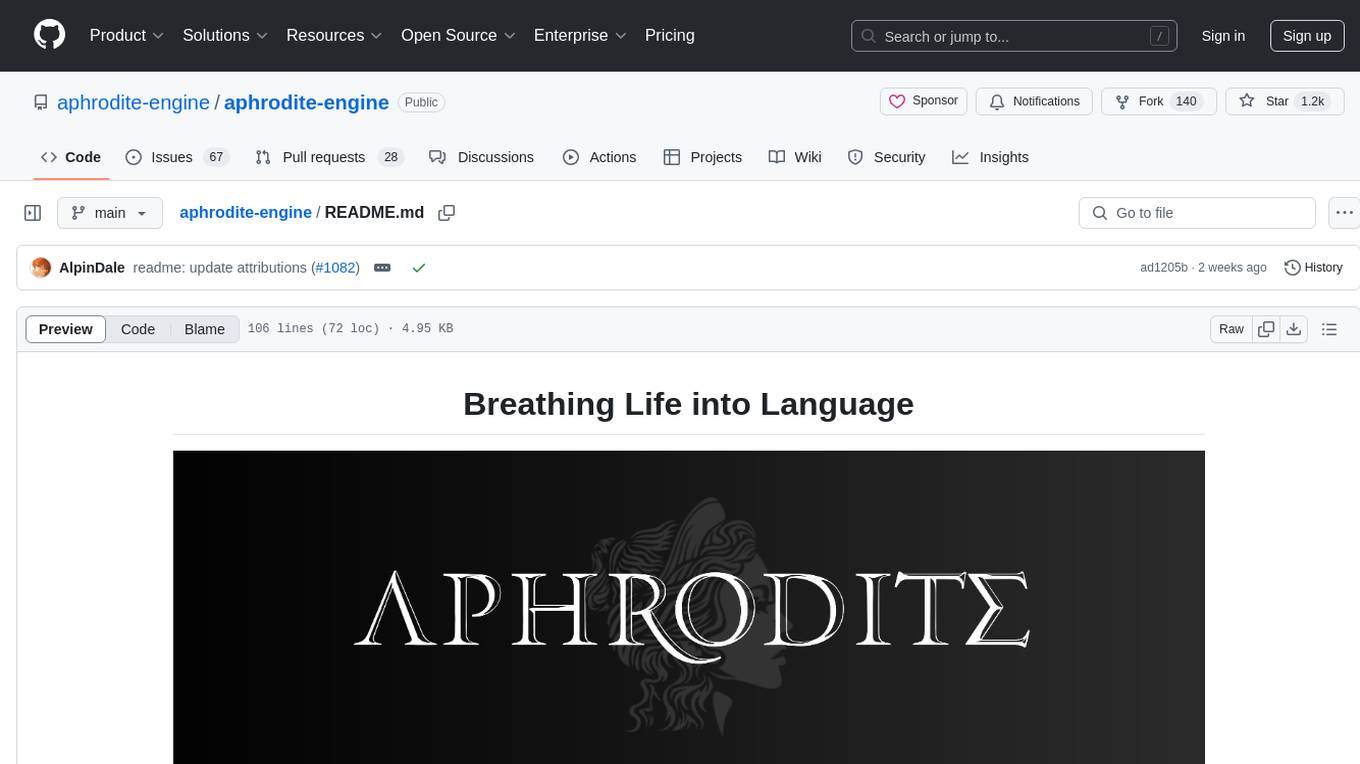
aphrodite-engine
Aphrodite is an inference engine optimized for serving HuggingFace-compatible models at scale. It leverages vLLM's Paged Attention technology to deliver high-performance model inference for multiple concurrent users. The engine supports continuous batching, efficient key/value management, optimized CUDA kernels, quantization support, distributed inference, and modern samplers. It can be easily installed and launched, with Docker support for deployment. Aphrodite requires Linux or Windows OS, Python 3.8 to 3.12, and CUDA >= 11. It is designed to utilize 90% of GPU VRAM but offers options to limit memory usage. Contributors are welcome to enhance the engine.
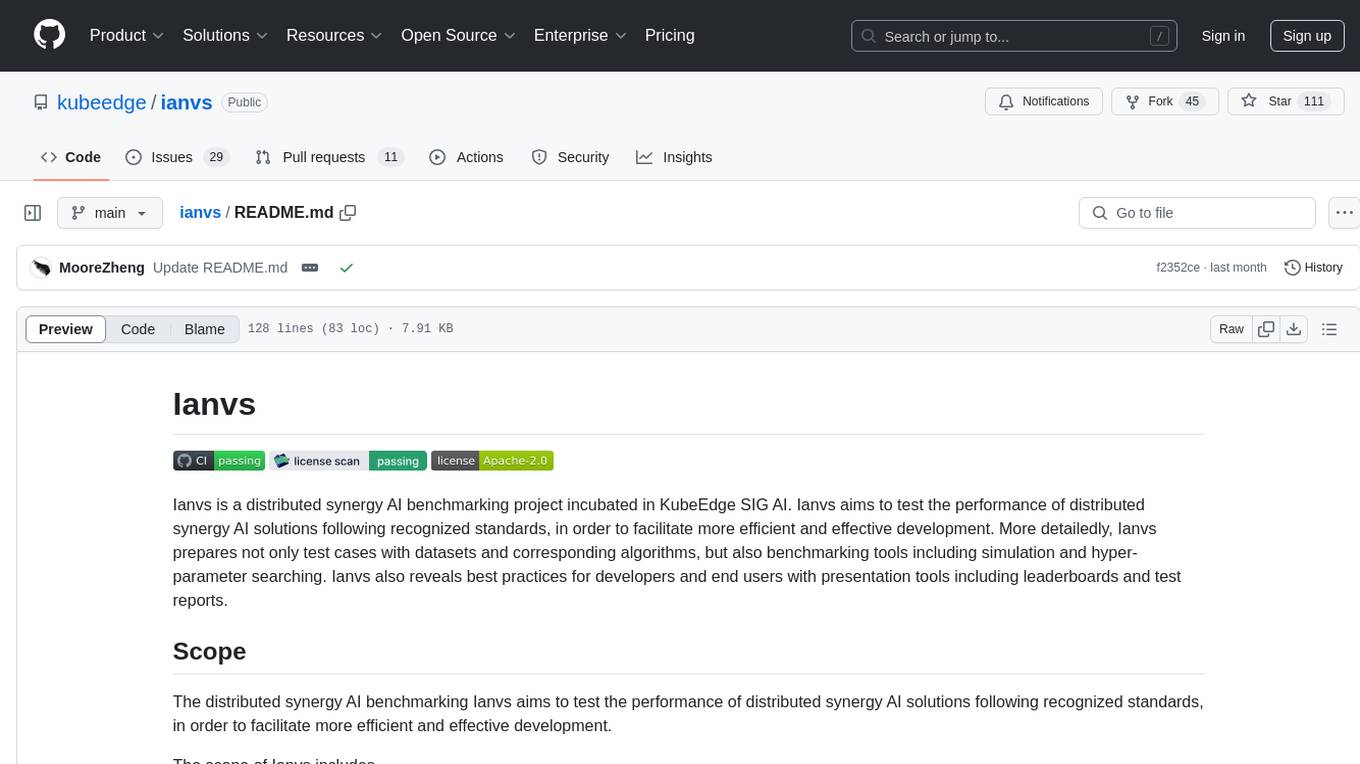
ianvs
Ianvs is a distributed synergy AI benchmarking project incubated in KubeEdge SIG AI. It aims to test the performance of distributed synergy AI solutions following recognized standards, providing end-to-end benchmark toolkits, test environment management tools, test case control tools, and benchmark presentation tools. It also collaborates with other organizations to establish comprehensive benchmarks and related applications. The architecture includes critical components like Test Environment Manager, Test Case Controller, Generation Assistant, Simulation Controller, and Story Manager. Ianvs documentation covers quick start, guides, dataset descriptions, algorithms, user interfaces, stories, and roadmap.
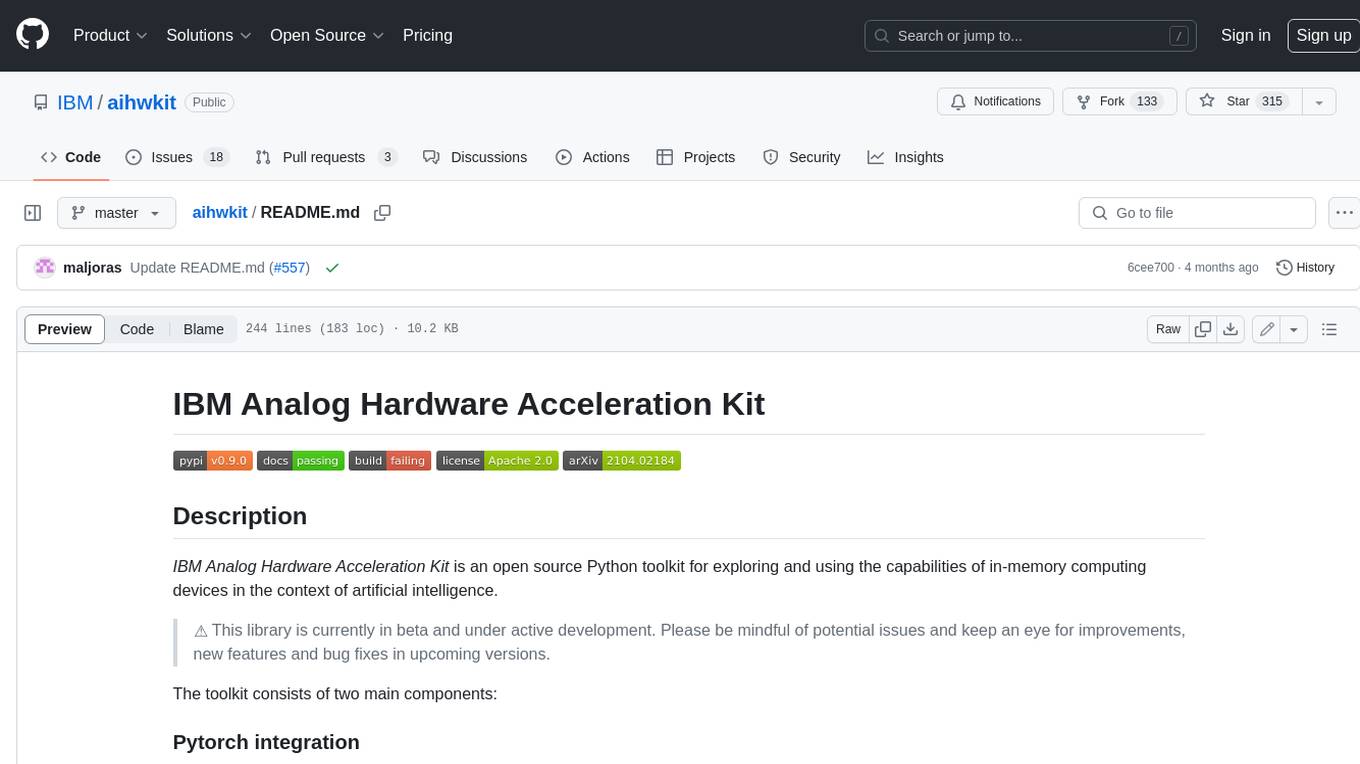
aihwkit
The IBM Analog Hardware Acceleration Kit is an open-source Python toolkit for exploring and using the capabilities of in-memory computing devices in the context of artificial intelligence. It consists of two main components: Pytorch integration and Analog devices simulator. The Pytorch integration provides a series of primitives and features that allow using the toolkit within PyTorch, including analog neural network modules, analog training using torch training workflow, and analog inference using torch inference workflow. The Analog devices simulator is a high-performant (CUDA-capable) C++ simulator that allows for simulating a wide range of analog devices and crossbar configurations by using abstract functional models of material characteristics with adjustable parameters. Along with the two main components, the toolkit includes other functionalities such as a library of device presets, a module for executing high-level use cases, a utility to automatically convert a downloaded model to its equivalent Analog model, and integration with the AIHW Composer platform. The toolkit is currently in beta and under active development, and users are advised to be mindful of potential issues and keep an eye for improvements, new features, and bug fixes in upcoming versions.
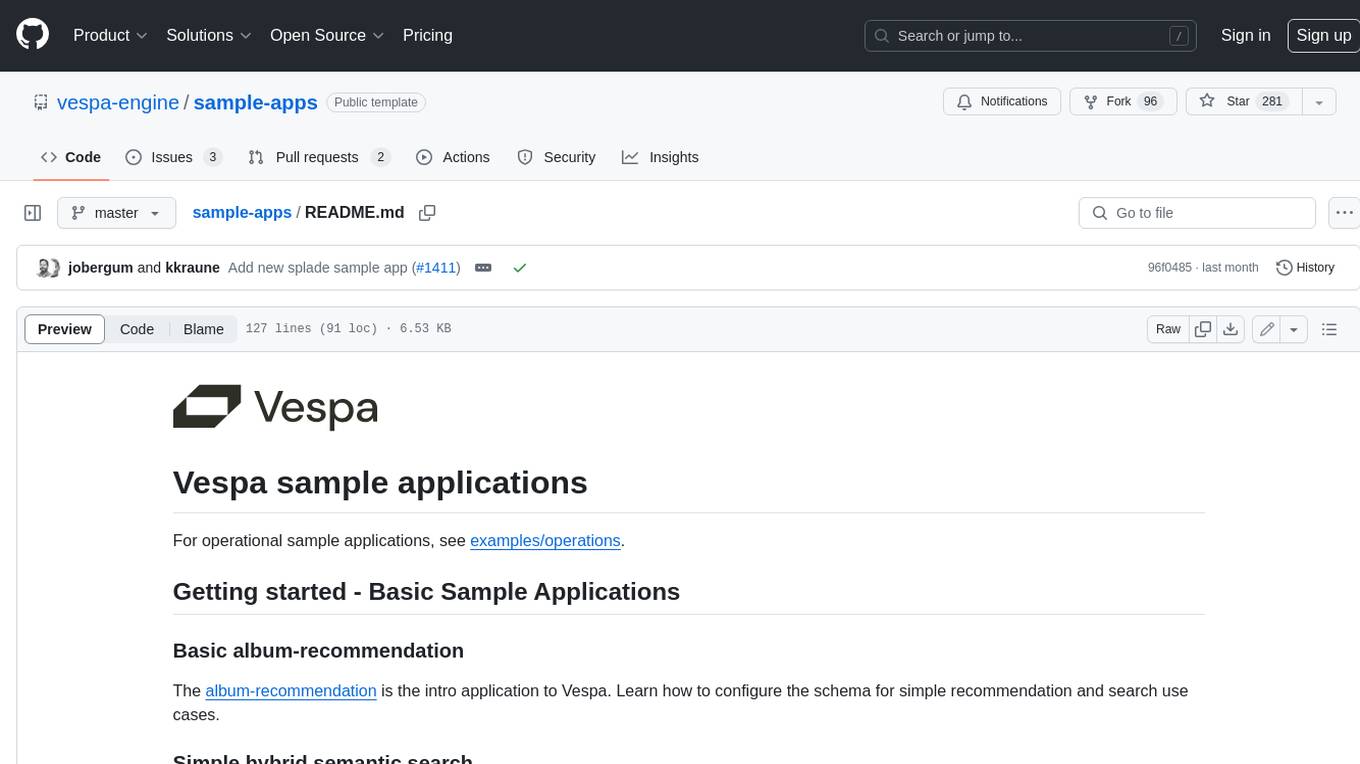
sample-apps
Vespa is an open-source search and AI engine that provides a unified platform for building and deploying search and AI applications. Vespa sample applications showcase various use cases and features of Vespa, including basic search, recommendation, semantic search, image search, text ranking, e-commerce search, question answering, search-as-you-type, and ML inference serving.

agentUniverse
agentUniverse is a multi-agent framework based on large language models, providing flexible capabilities for building individual agents. It focuses on collaborative pattern components to solve problems in various fields and integrates domain experience. The framework supports LLM model integration and offers various pattern components like PEER and DOE. Users can easily configure models and set up agents for tasks. agentUniverse aims to assist developers and enterprises in constructing domain-expert-level intelligent agents for seamless collaboration.
For similar tasks

confabulations
LLM Confabulation Leaderboard evaluates large language models based on confabulations and non-response rates to challenging questions. It includes carefully curated questions with no answers in provided texts, aiming to differentiate between various models. The benchmark combines confabulation and non-response rates for comprehensive ranking, offering insights into model performance and tendencies. Additional notes highlight the meticulous human verification process, challenges faced by LLMs in generating valid responses, and the use of temperature settings. Updates and other benchmarks are also mentioned, providing a holistic view of the evaluation landscape.
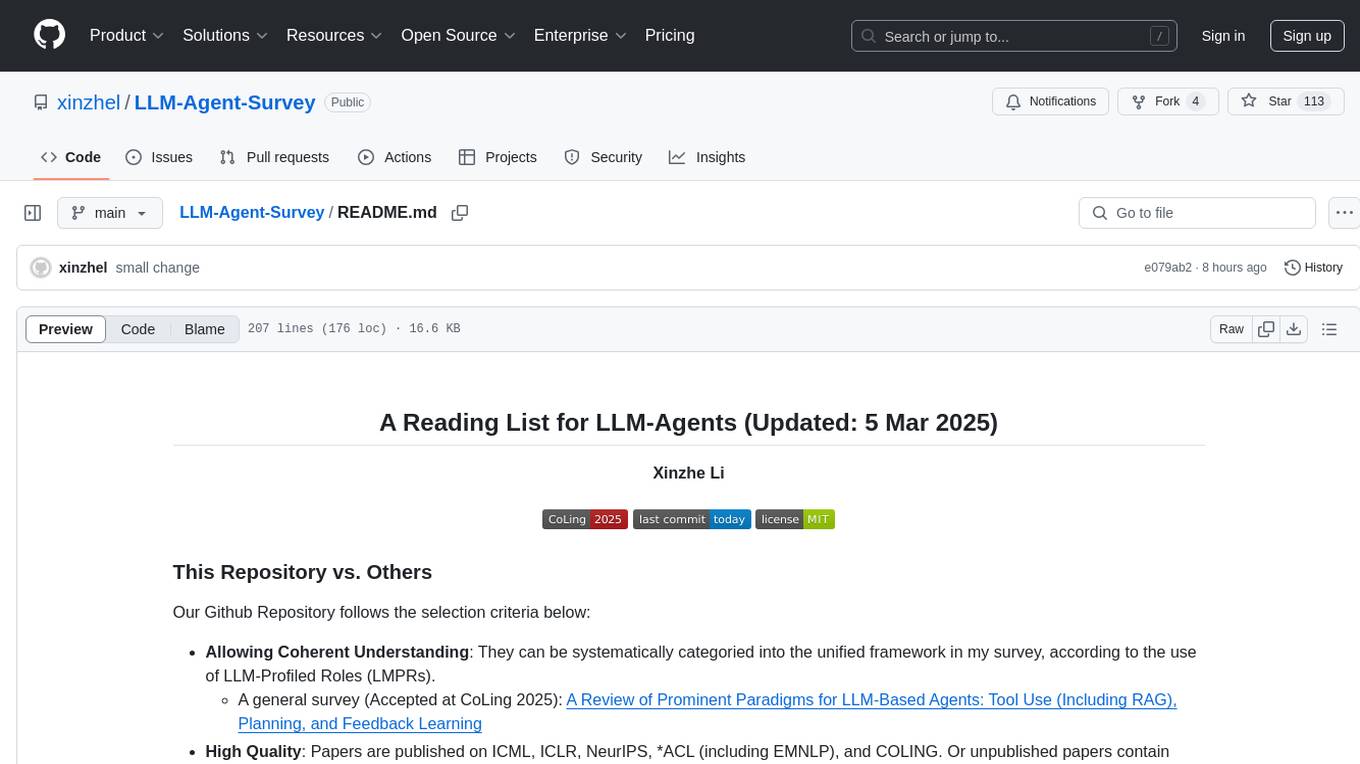
LLM-Agent-Survey
LLM-Agent-Survey is a comprehensive repository that provides a curated list of papers related to Large Language Model (LLM) agents. The repository categorizes papers based on LLM-Profiled Roles and includes high-quality publications from prestigious conferences and journals. It aims to offer a systematic understanding of LLM-based agents, covering topics such as tool use, planning, and feedback learning. The repository also includes unpublished papers with insightful analysis and novelty, marked for future updates. Users can explore a wide range of surveys, tool use cases, planning workflows, and benchmarks related to LLM agents.
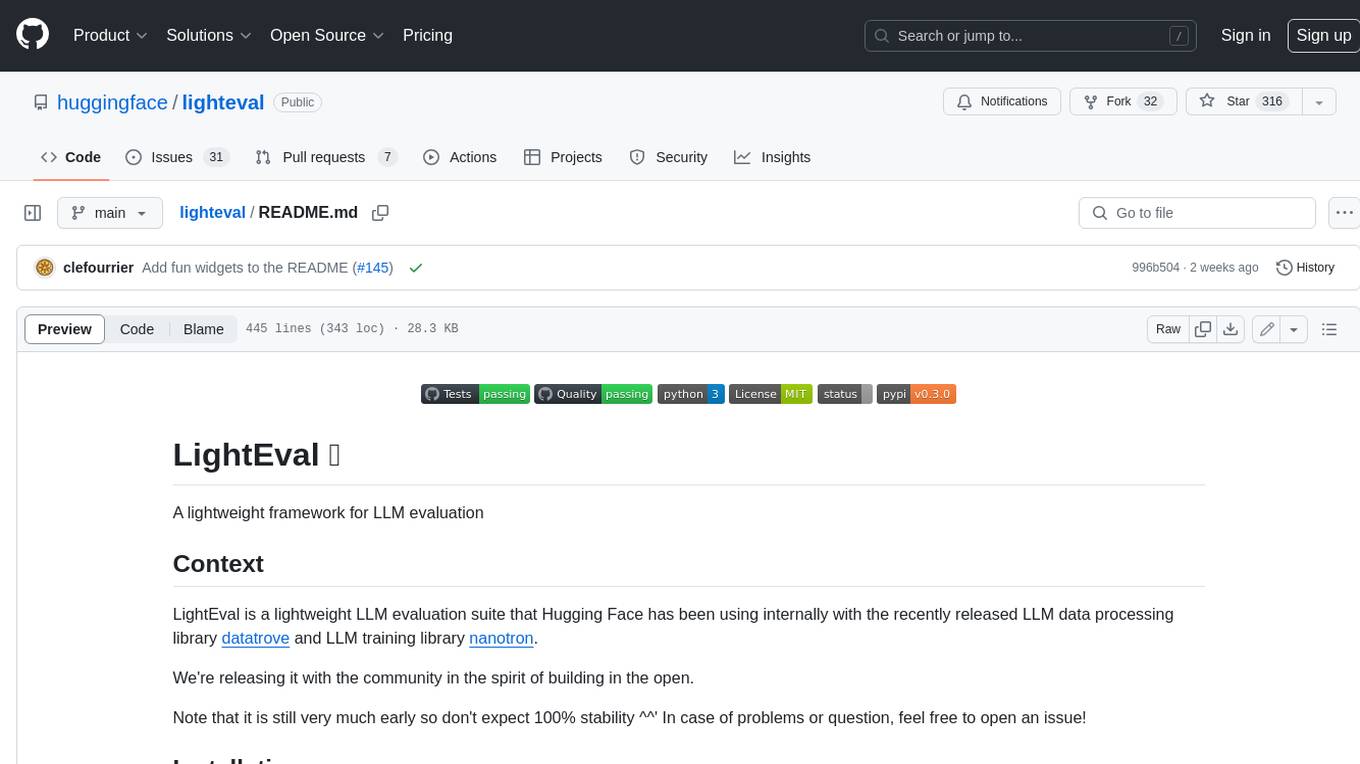
lighteval
LightEval is a lightweight LLM evaluation suite that Hugging Face has been using internally with the recently released LLM data processing library datatrove and LLM training library nanotron. We're releasing it with the community in the spirit of building in the open. Note that it is still very much early so don't expect 100% stability ^^' In case of problems or question, feel free to open an issue!
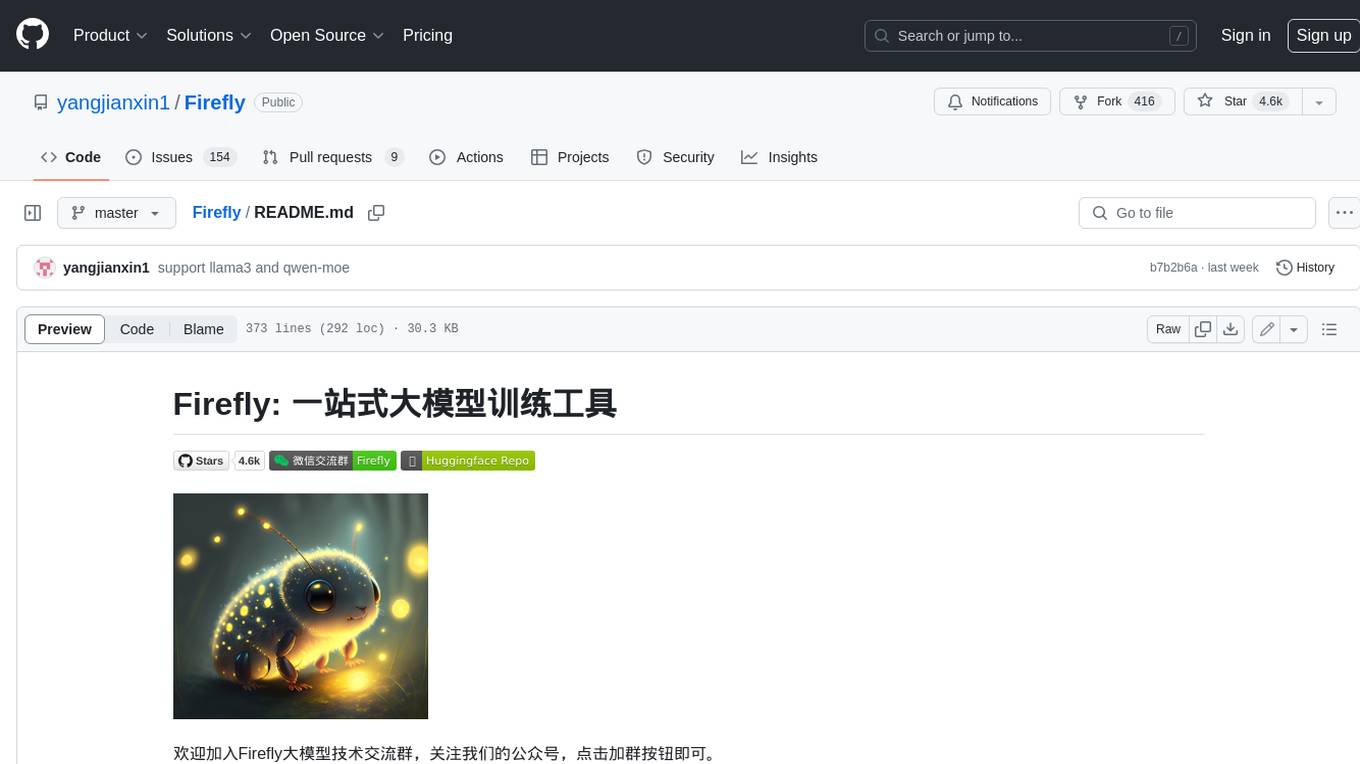
Firefly
Firefly is an open-source large model training project that supports pre-training, fine-tuning, and DPO of mainstream large models. It includes models like Llama3, Gemma, Qwen1.5, MiniCPM, Llama, InternLM, Baichuan, ChatGLM, Yi, Deepseek, Qwen, Orion, Ziya, Xverse, Mistral, Mixtral-8x7B, Zephyr, Vicuna, Bloom, etc. The project supports full-parameter training, LoRA, QLoRA efficient training, and various tasks such as pre-training, SFT, and DPO. Suitable for users with limited training resources, QLoRA is recommended for fine-tuning instructions. The project has achieved good results on the Open LLM Leaderboard with QLoRA training process validation. The latest version has significant updates and adaptations for different chat model templates.
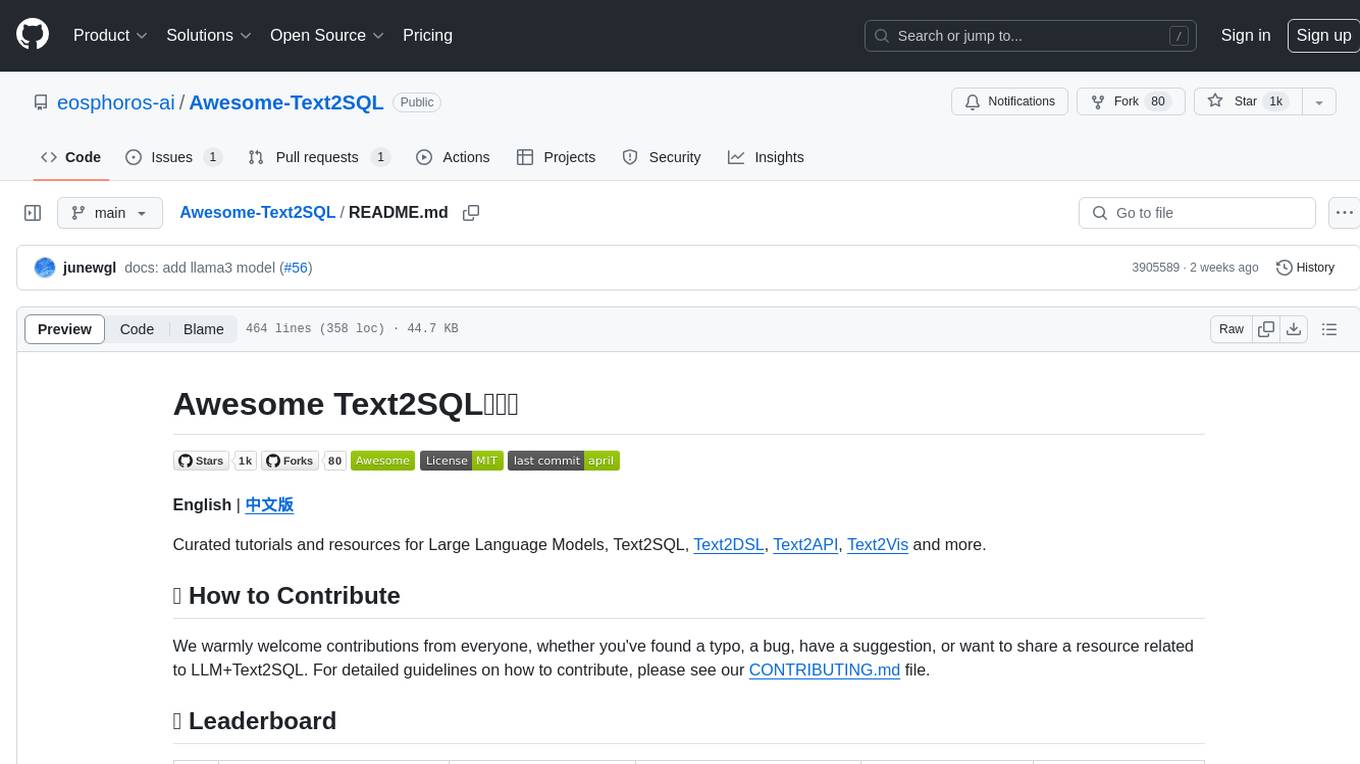
Awesome-Text2SQL
Awesome Text2SQL is a curated repository containing tutorials and resources for Large Language Models, Text2SQL, Text2DSL, Text2API, Text2Vis, and more. It provides guidelines on converting natural language questions into structured SQL queries, with a focus on NL2SQL. The repository includes information on various models, datasets, evaluation metrics, fine-tuning methods, libraries, and practice projects related to Text2SQL. It serves as a comprehensive resource for individuals interested in working with Text2SQL and related technologies.
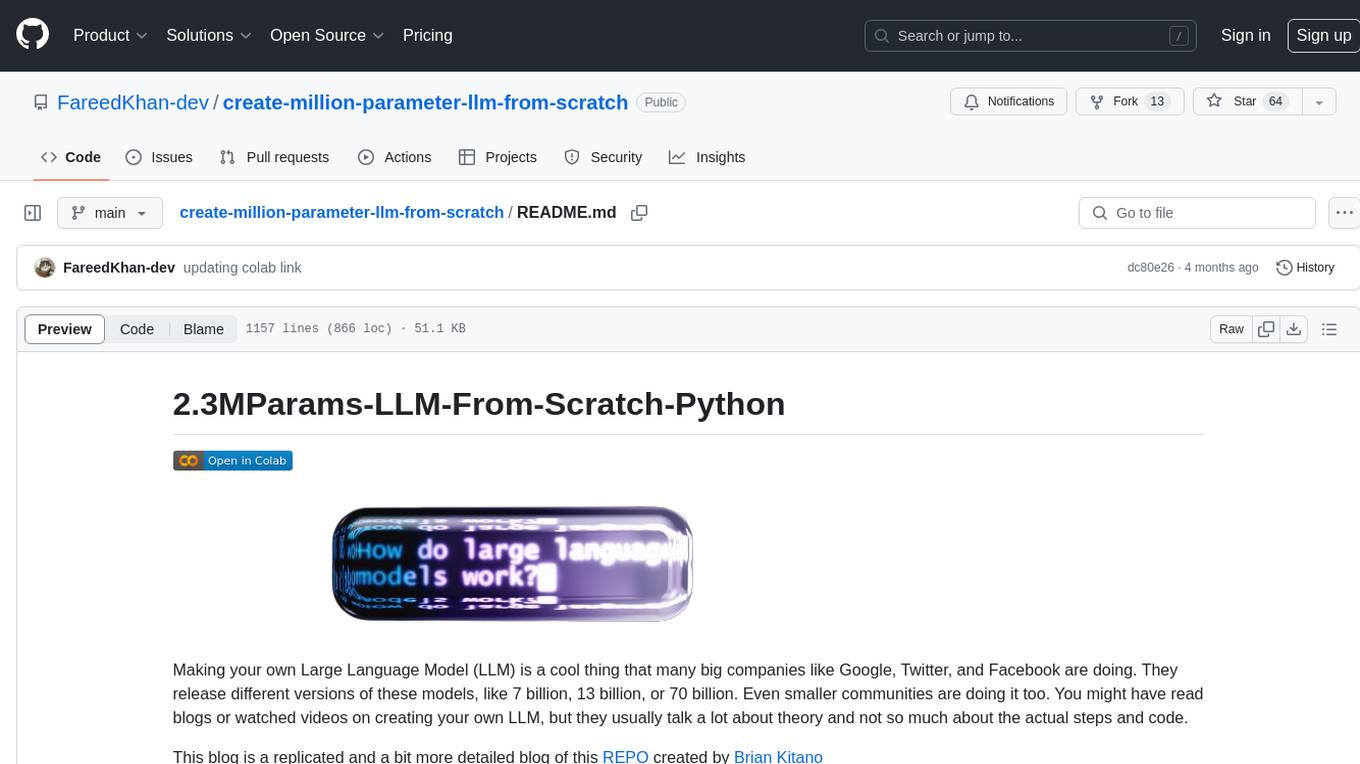
create-million-parameter-llm-from-scratch
The 'create-million-parameter-llm-from-scratch' repository provides a detailed guide on creating a Large Language Model (LLM) with 2.3 million parameters from scratch. The blog replicates the LLaMA approach, incorporating concepts like RMSNorm for pre-normalization, SwiGLU activation function, and Rotary Embeddings. The model is trained on a basic dataset to demonstrate the ease of creating a million-parameter LLM without the need for a high-end GPU.
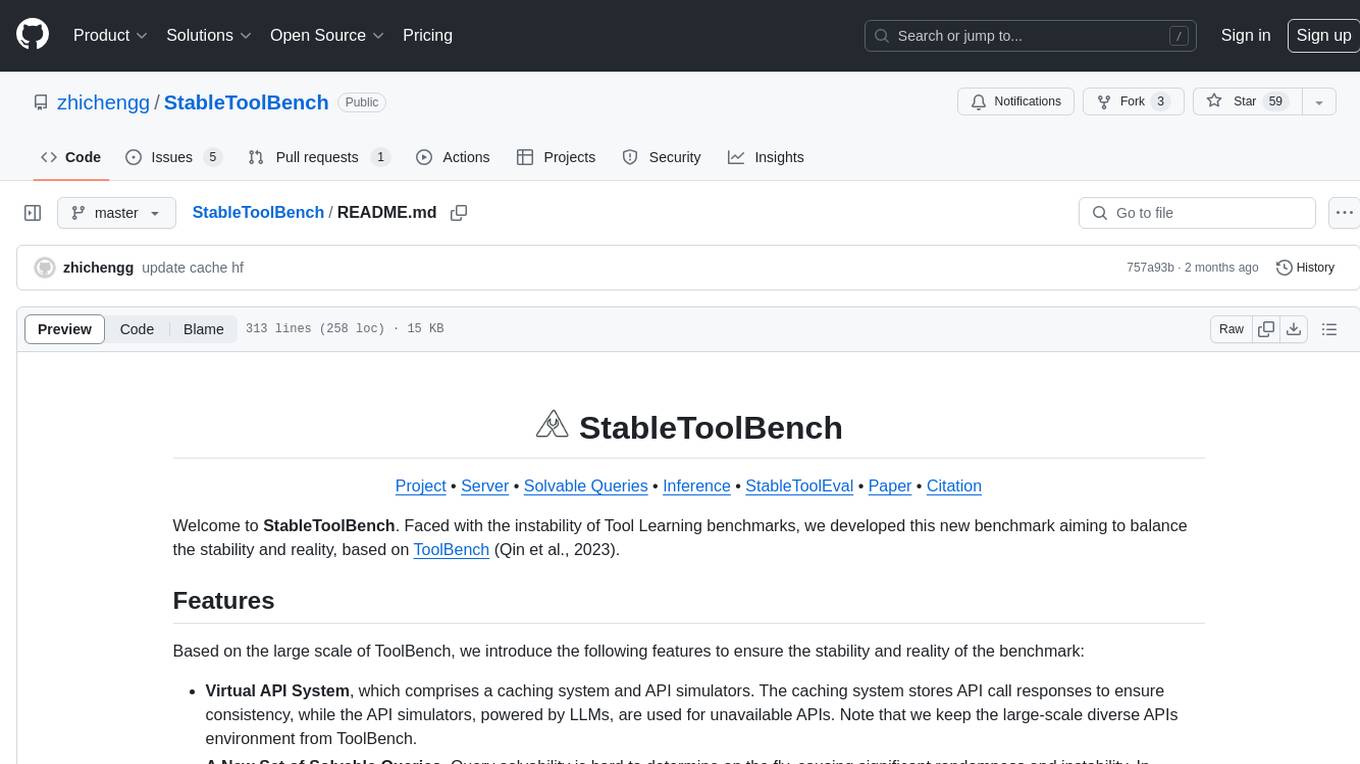
StableToolBench
StableToolBench is a new benchmark developed to address the instability of Tool Learning benchmarks. It aims to balance stability and reality by introducing features such as a Virtual API System with caching and API simulators, a new set of solvable queries determined by LLMs, and a Stable Evaluation System using GPT-4. The Virtual API Server can be set up either by building from source or using a prebuilt Docker image. Users can test the server using provided scripts and evaluate models with Solvable Pass Rate and Solvable Win Rate metrics. The tool also includes model experiments results comparing different models' performance.
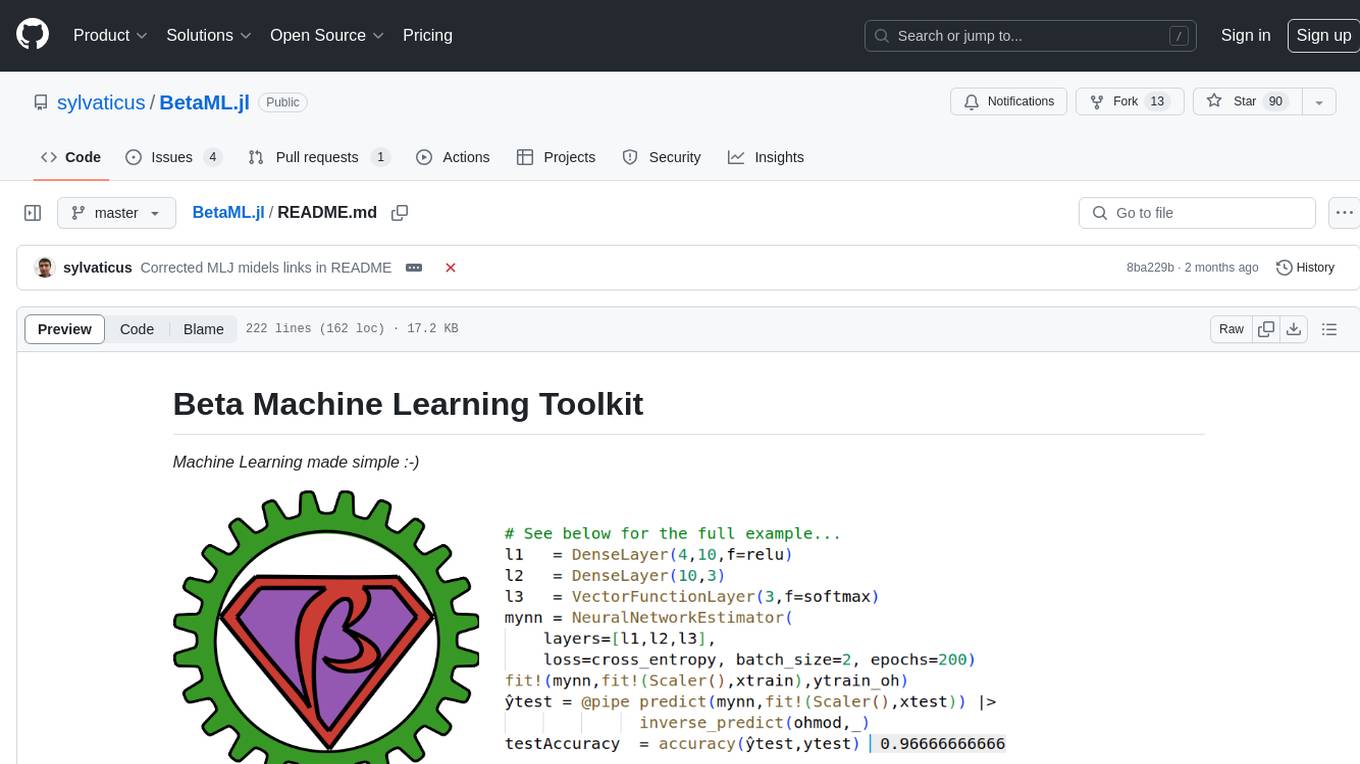
BetaML.jl
The Beta Machine Learning Toolkit is a package containing various algorithms and utilities for implementing machine learning workflows in multiple languages, including Julia, Python, and R. It offers a range of supervised and unsupervised models, data transformers, and assessment tools. The models are implemented entirely in Julia and are not wrappers for third-party models. Users can easily contribute new models or request implementations. The focus is on user-friendliness rather than computational efficiency, making it suitable for educational and research purposes.
For similar jobs
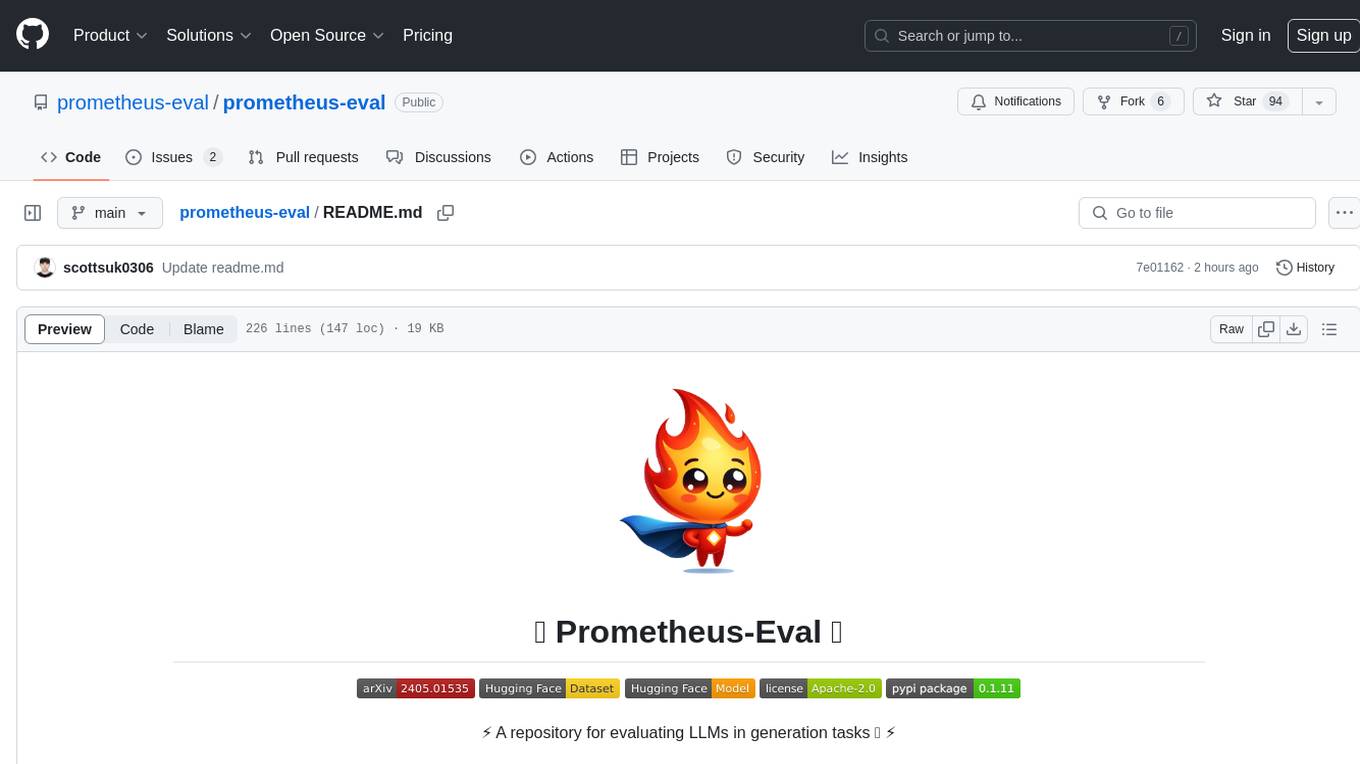
prometheus-eval
Prometheus-Eval is a repository dedicated to evaluating large language models (LLMs) in generation tasks. It provides state-of-the-art language models like Prometheus 2 (7B & 8x7B) for assessing in pairwise ranking formats and achieving high correlation scores with benchmarks. The repository includes tools for training, evaluating, and using these models, along with scripts for fine-tuning on custom datasets. Prometheus aims to address issues like fairness, controllability, and affordability in evaluations by simulating human judgments and proprietary LM-based assessments.
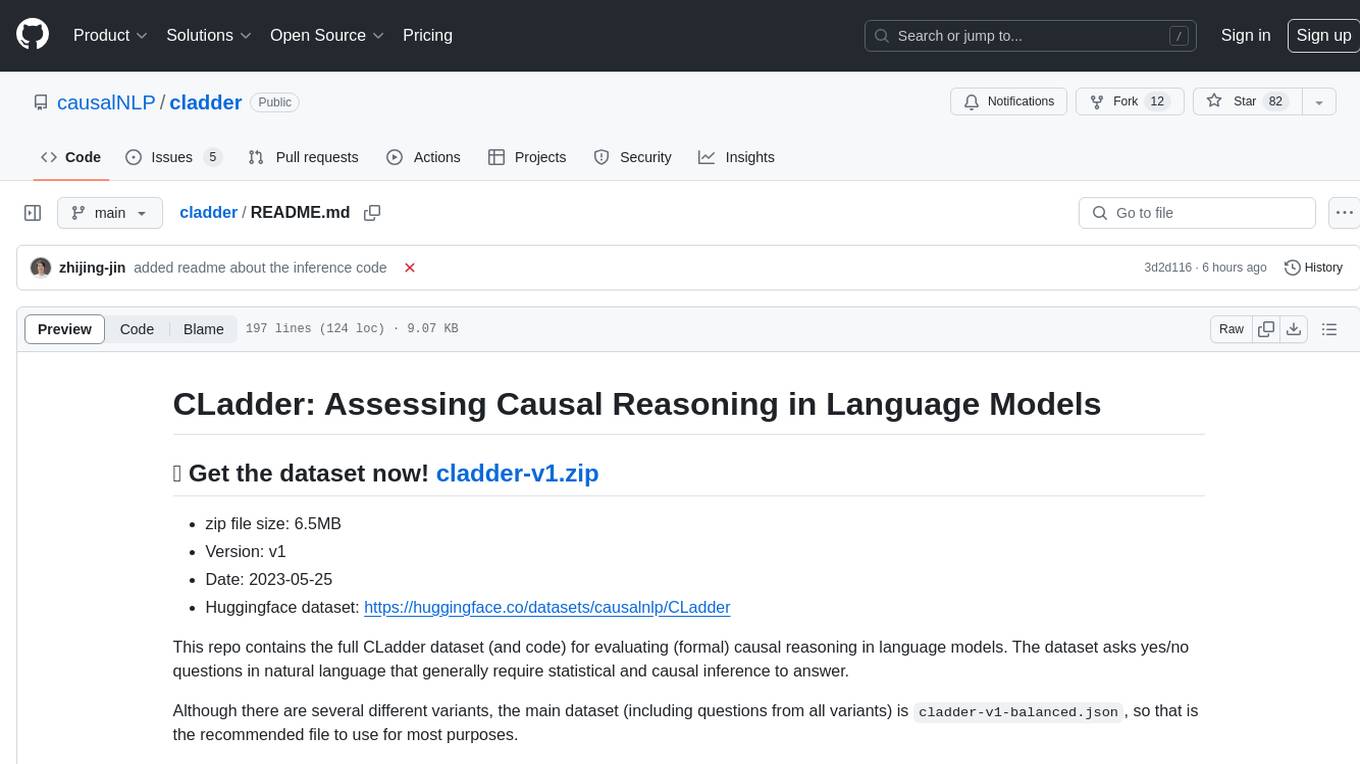
cladder
CLadder is a repository containing the CLadder dataset for evaluating causal reasoning in language models. The dataset consists of yes/no questions in natural language that require statistical and causal inference to answer. It includes fields such as question_id, given_info, question, answer, reasoning, and metadata like query_type and rung. The dataset also provides prompts for evaluating language models and example questions with associated reasoning steps. Additionally, it offers dataset statistics, data variants, and code setup instructions for using the repository.
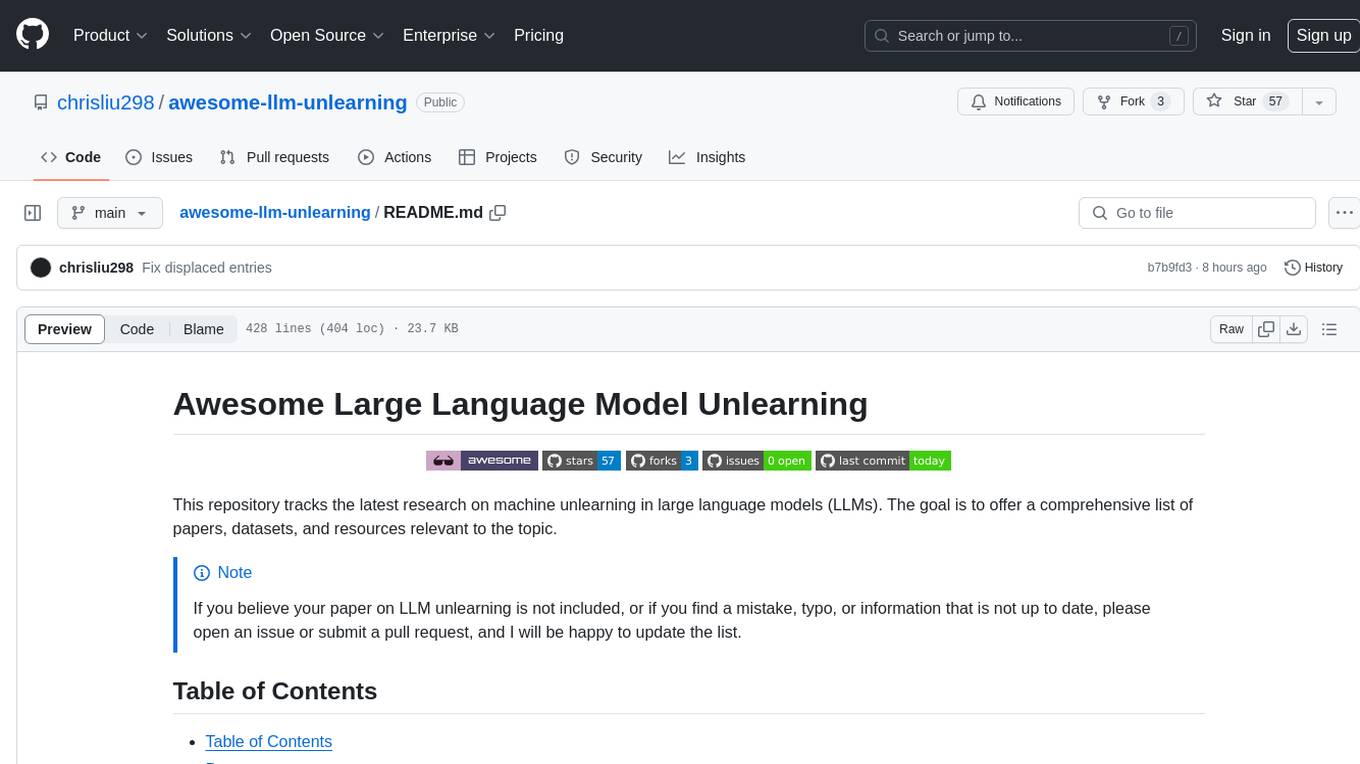
awesome-llm-unlearning
This repository tracks the latest research on machine unlearning in large language models (LLMs). It offers a comprehensive list of papers, datasets, and resources relevant to the topic.
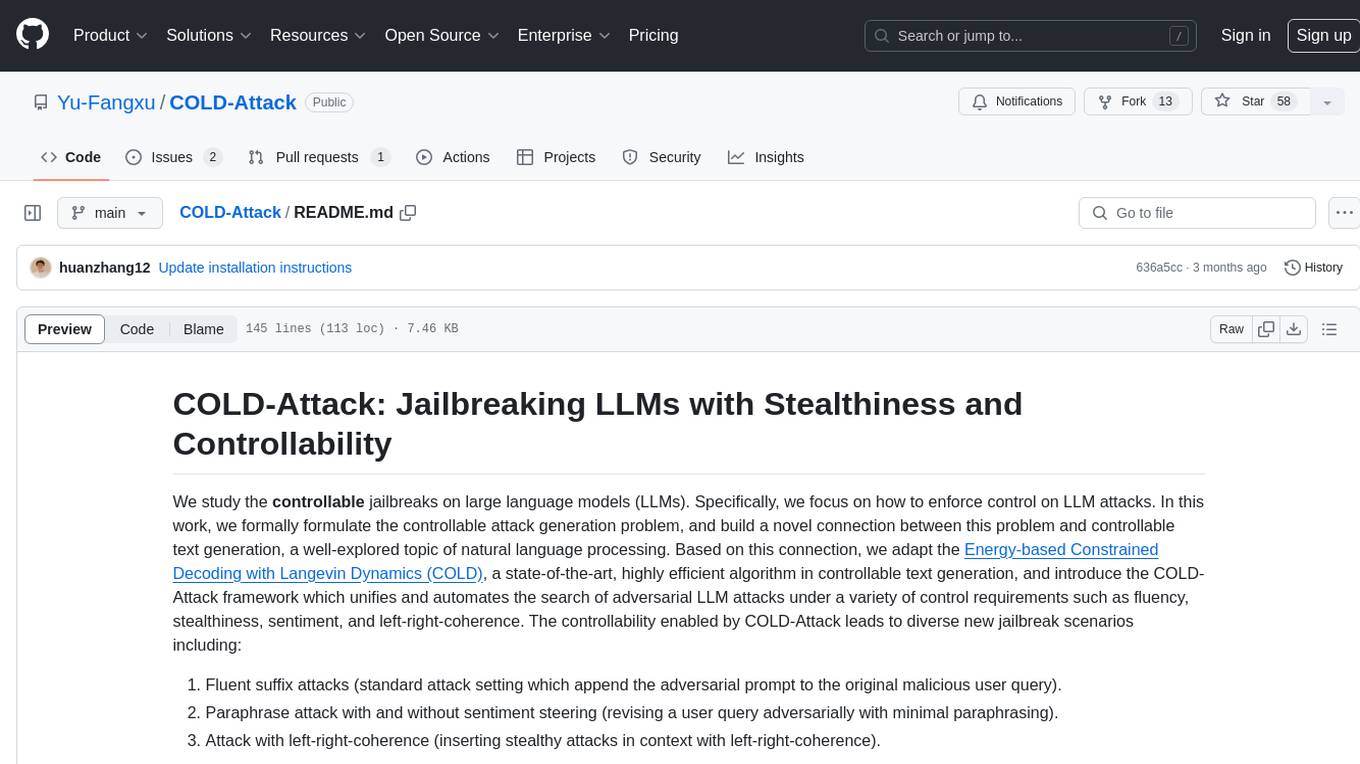
COLD-Attack
COLD-Attack is a framework designed for controllable jailbreaks on large language models (LLMs). It formulates the controllable attack generation problem and utilizes the Energy-based Constrained Decoding with Langevin Dynamics (COLD) algorithm to automate the search of adversarial LLM attacks with control over fluency, stealthiness, sentiment, and left-right-coherence. The framework includes steps for energy function formulation, Langevin dynamics sampling, and decoding process to generate discrete text attacks. It offers diverse jailbreak scenarios such as fluent suffix attacks, paraphrase attacks, and attacks with left-right-coherence.
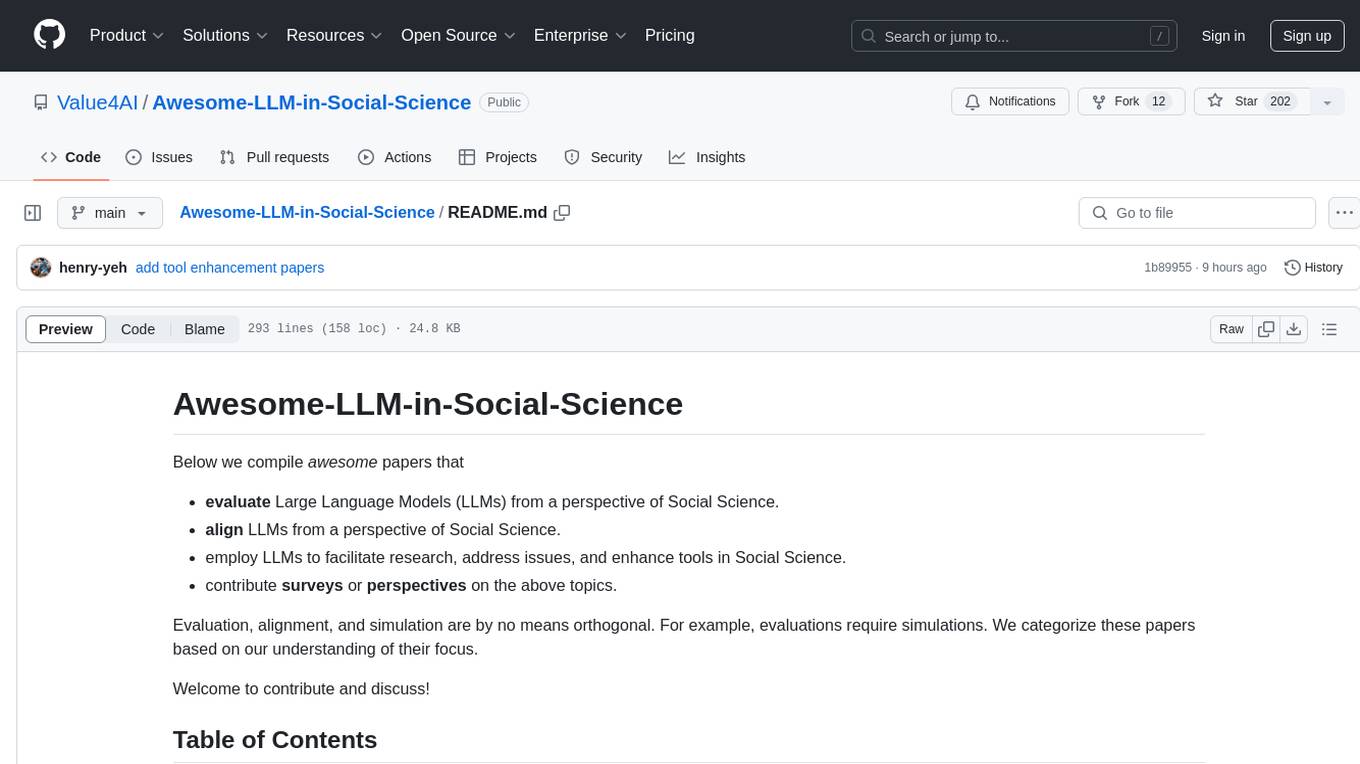
Awesome-LLM-in-Social-Science
Awesome-LLM-in-Social-Science is a repository that compiles papers evaluating Large Language Models (LLMs) from a social science perspective. It includes papers on evaluating, aligning, and simulating LLMs, as well as enhancing tools in social science research. The repository categorizes papers based on their focus on attitudes, opinions, values, personality, morality, and more. It aims to contribute to discussions on the potential and challenges of using LLMs in social science research.
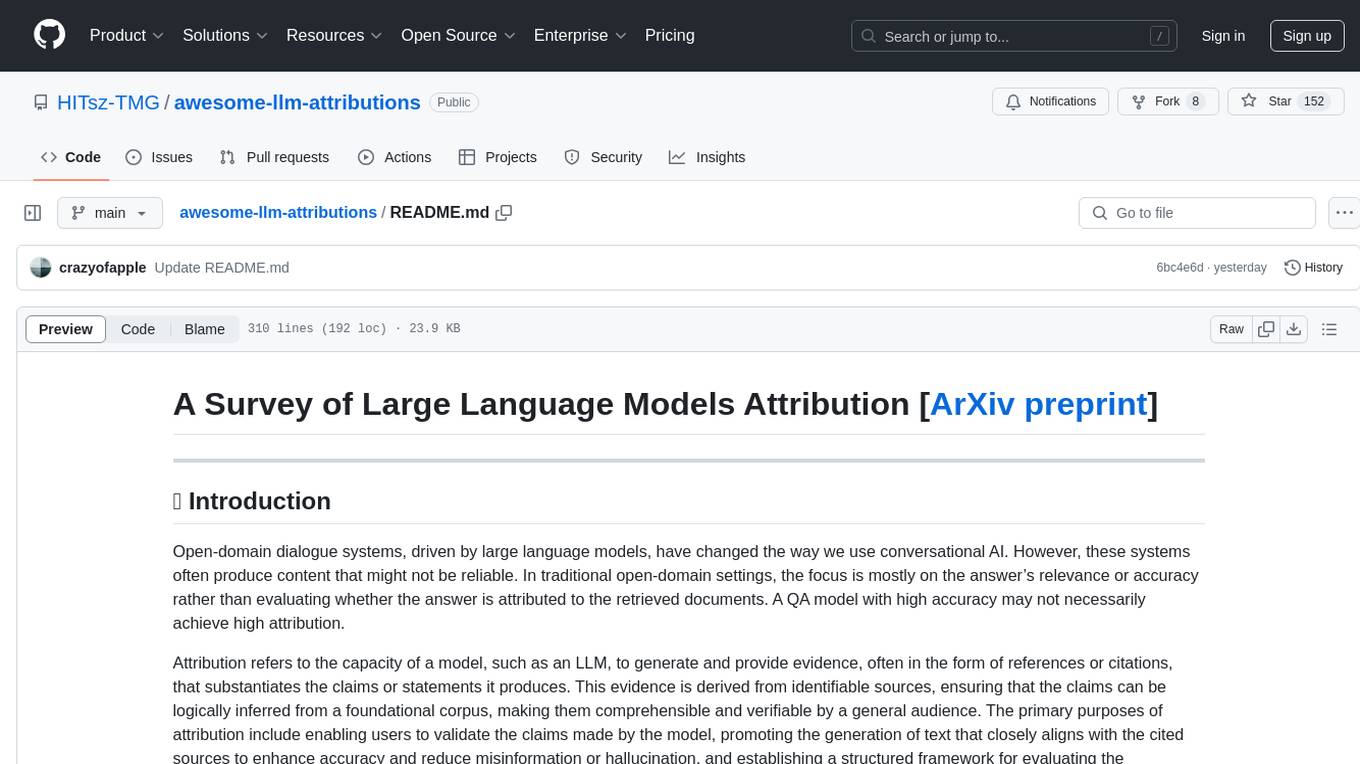
awesome-llm-attributions
This repository focuses on unraveling the sources that large language models tap into for attribution or citation. It delves into the origins of facts, their utilization by the models, the efficacy of attribution methodologies, and challenges tied to ambiguous knowledge reservoirs, biases, and pitfalls of excessive attribution.
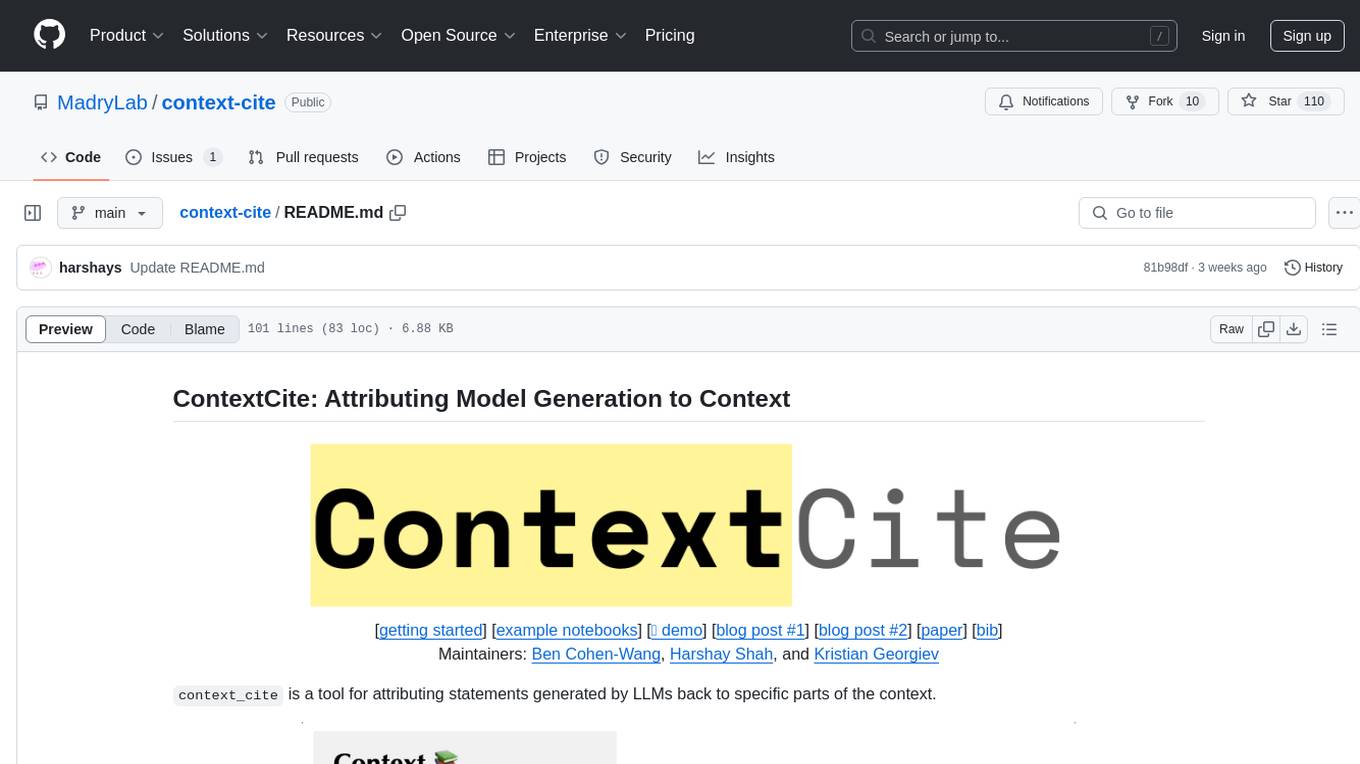
context-cite
ContextCite is a tool for attributing statements generated by LLMs back to specific parts of the context. It allows users to analyze and understand the sources of information used by language models in generating responses. By providing attributions, users can gain insights into how the model makes decisions and where the information comes from.

confabulations
LLM Confabulation Leaderboard evaluates large language models based on confabulations and non-response rates to challenging questions. It includes carefully curated questions with no answers in provided texts, aiming to differentiate between various models. The benchmark combines confabulation and non-response rates for comprehensive ranking, offering insights into model performance and tendencies. Additional notes highlight the meticulous human verification process, challenges faced by LLMs in generating valid responses, and the use of temperature settings. Updates and other benchmarks are also mentioned, providing a holistic view of the evaluation landscape.